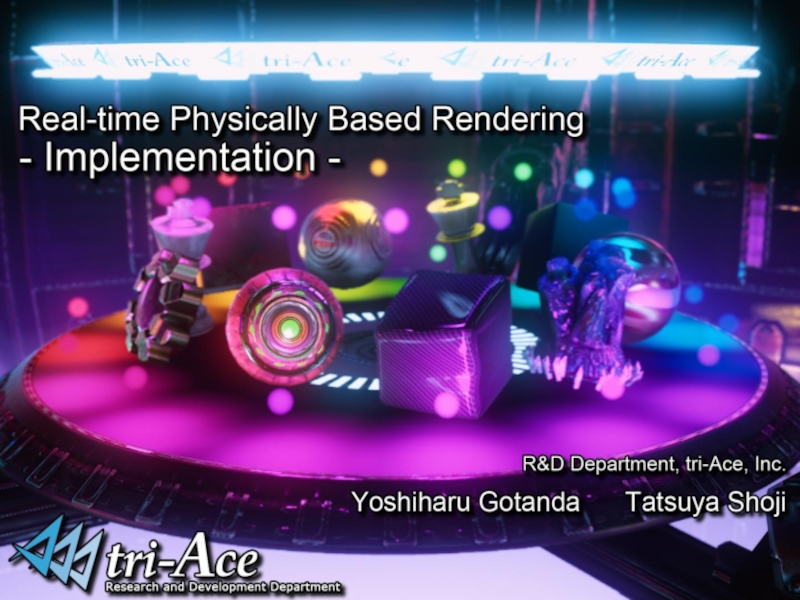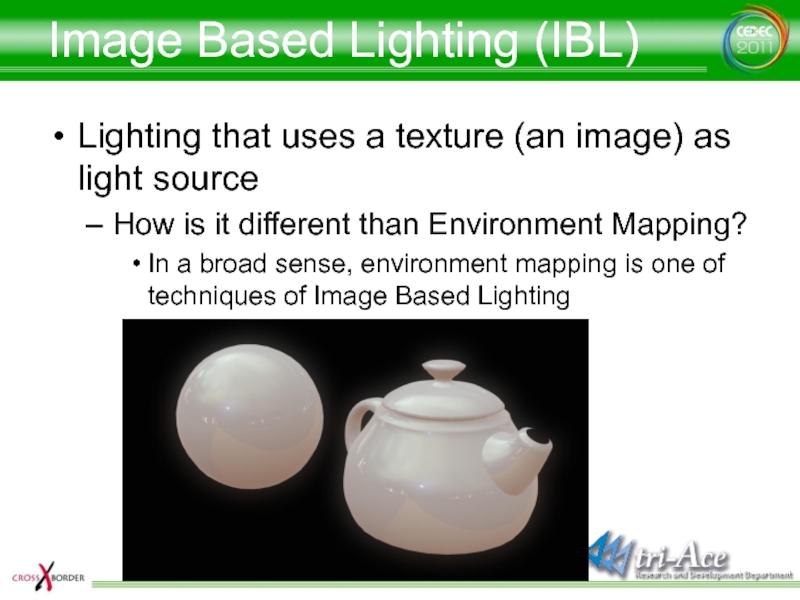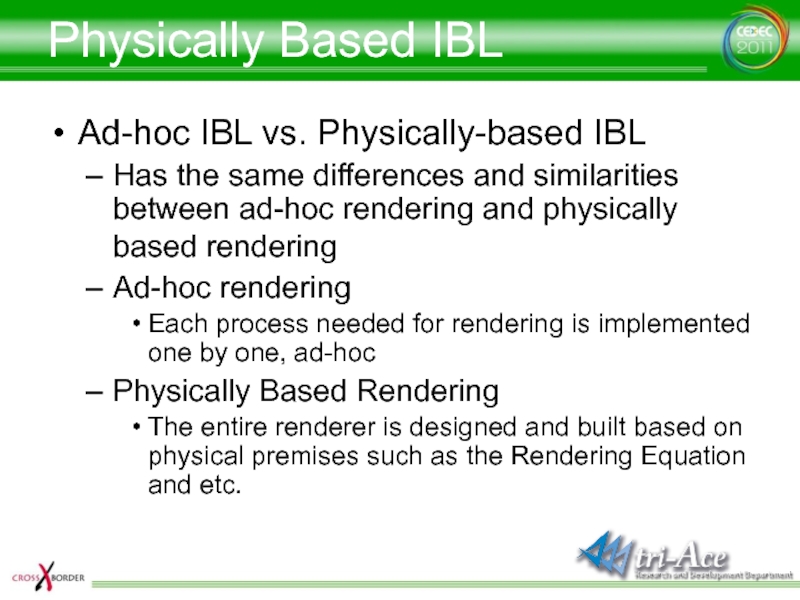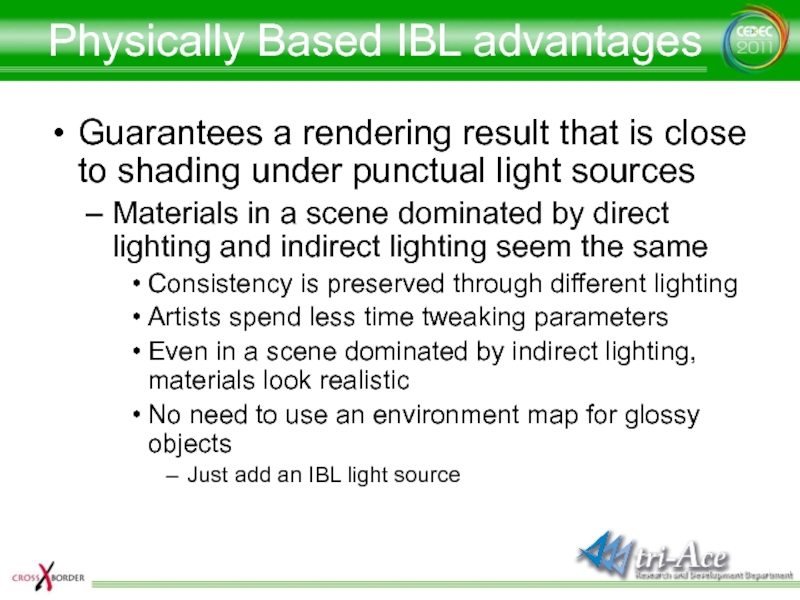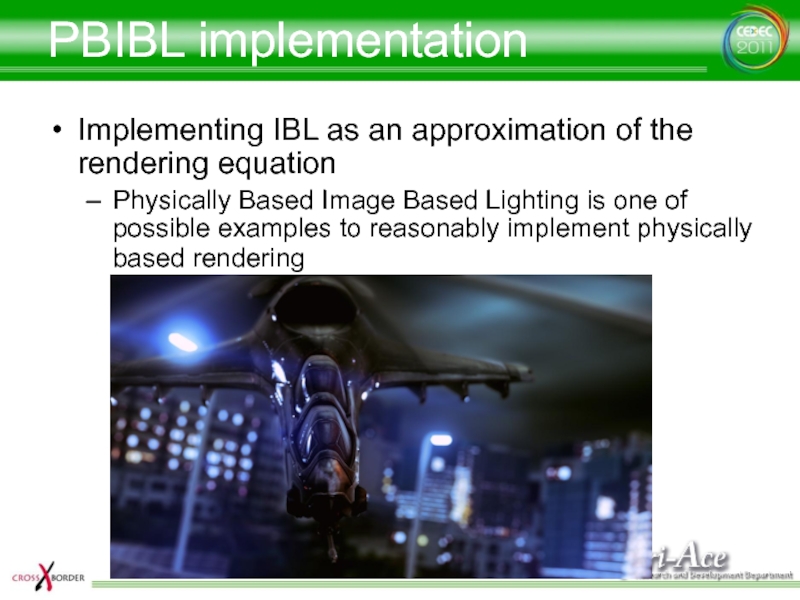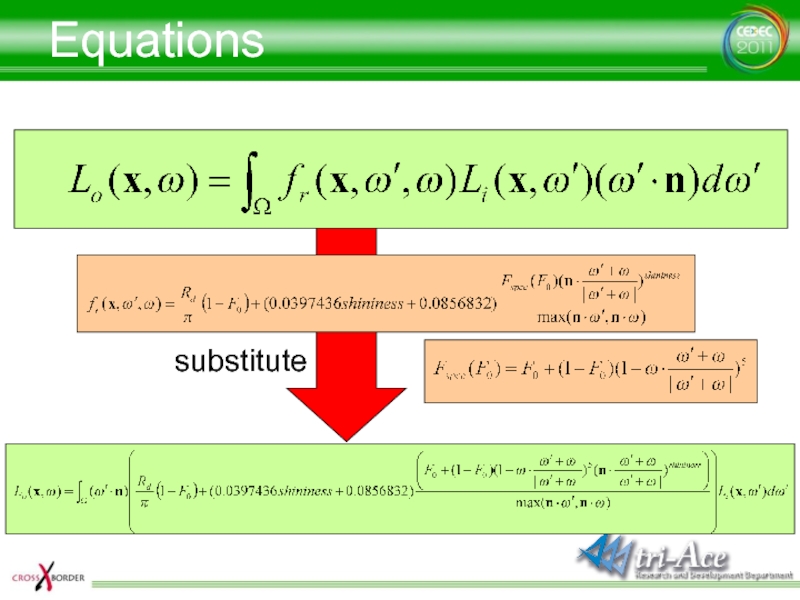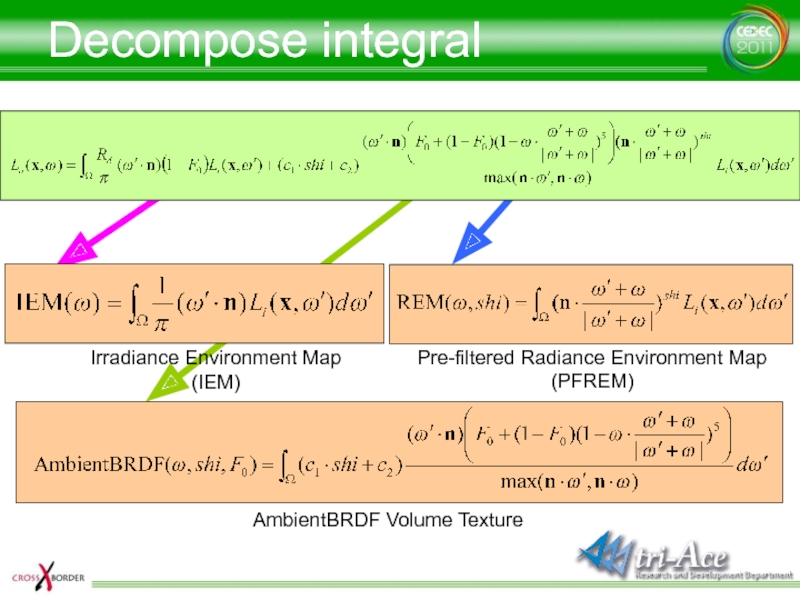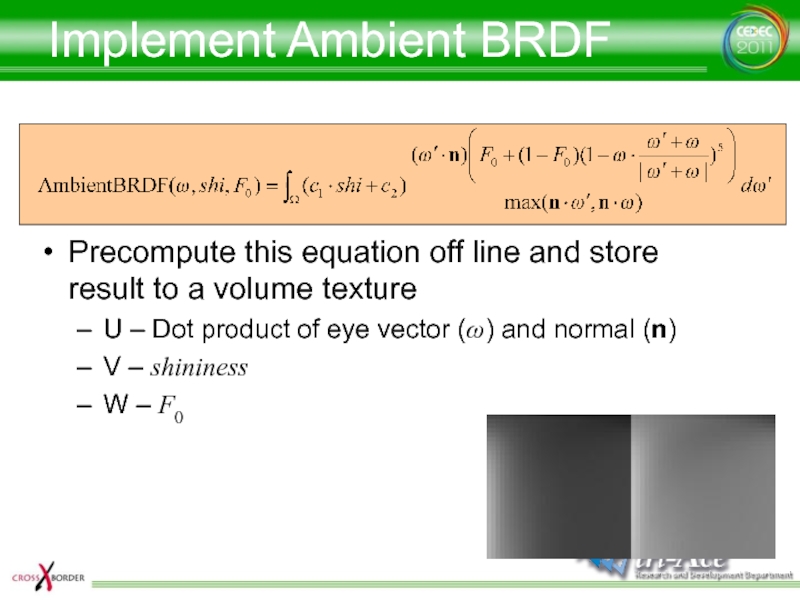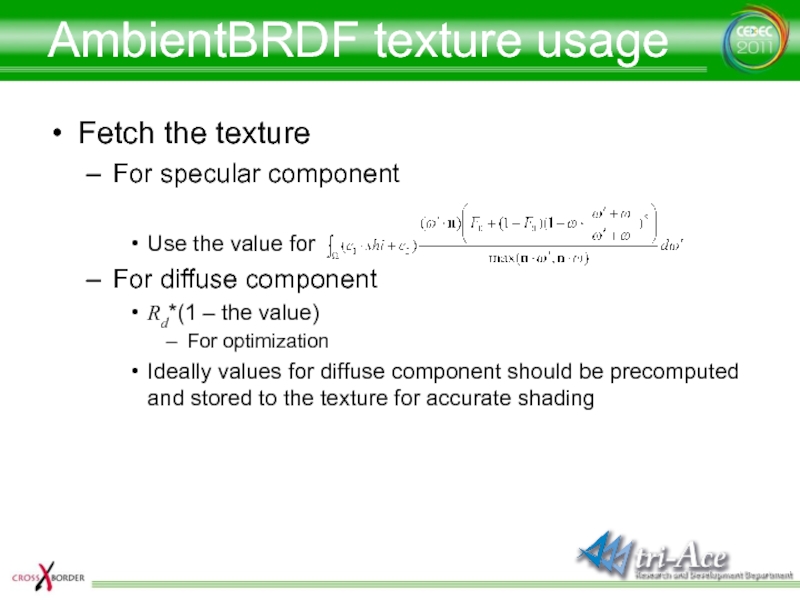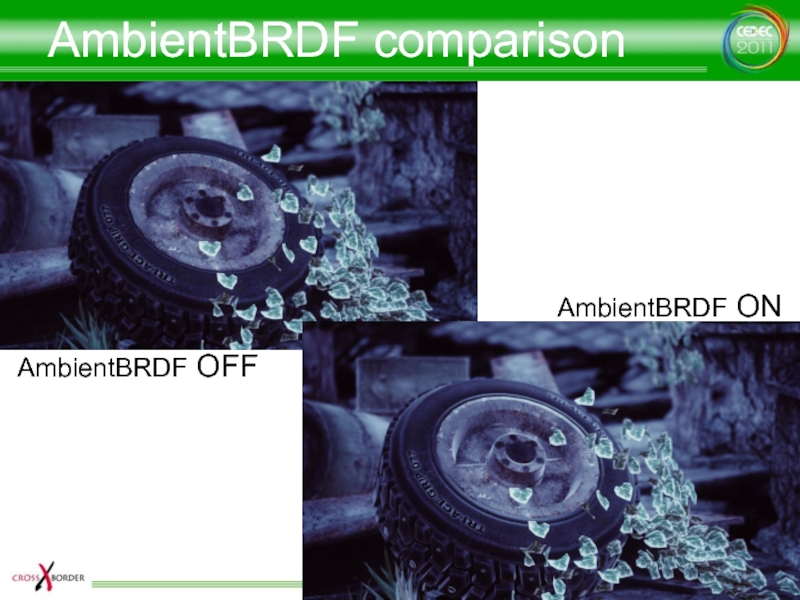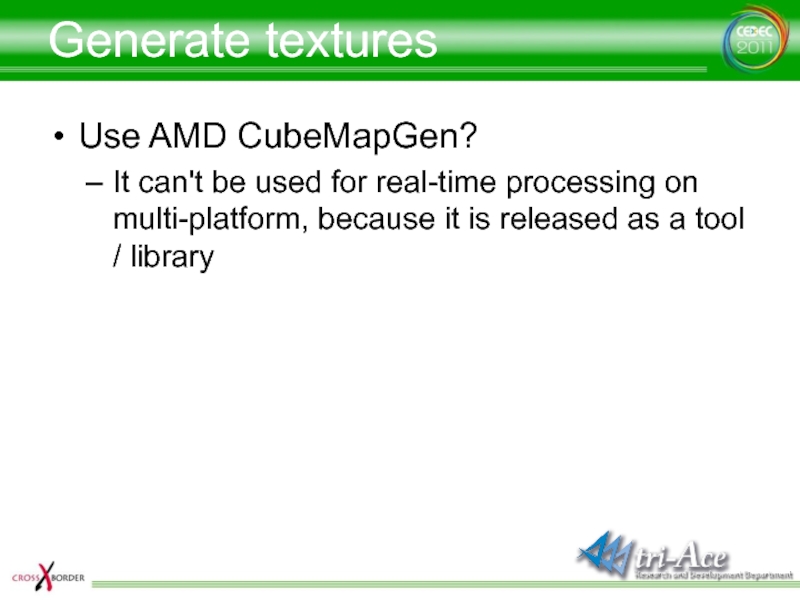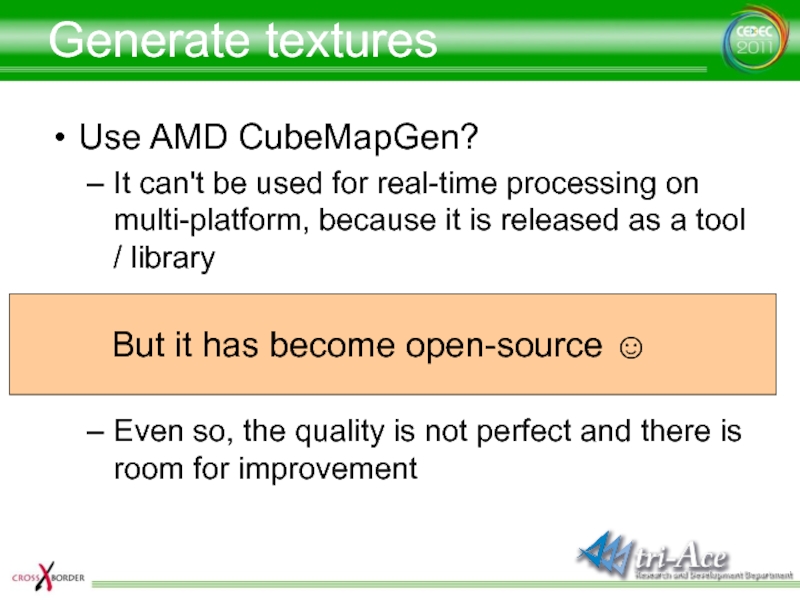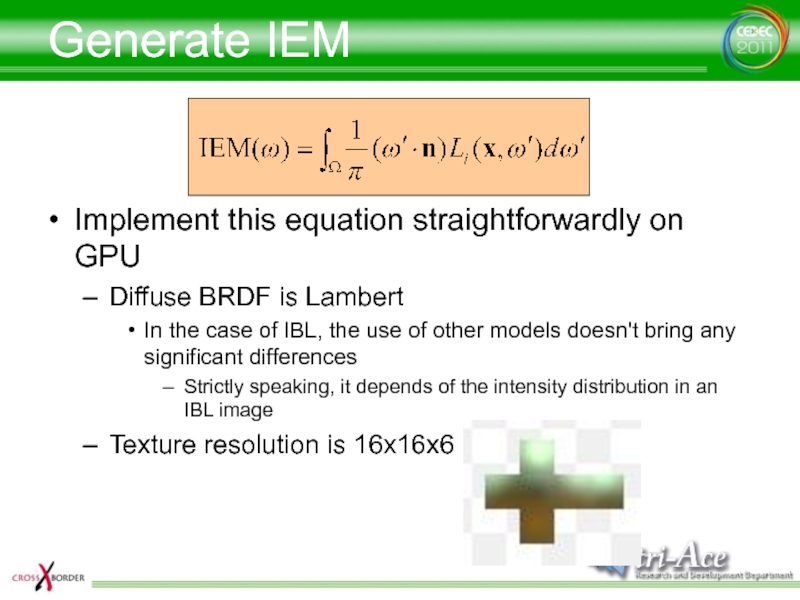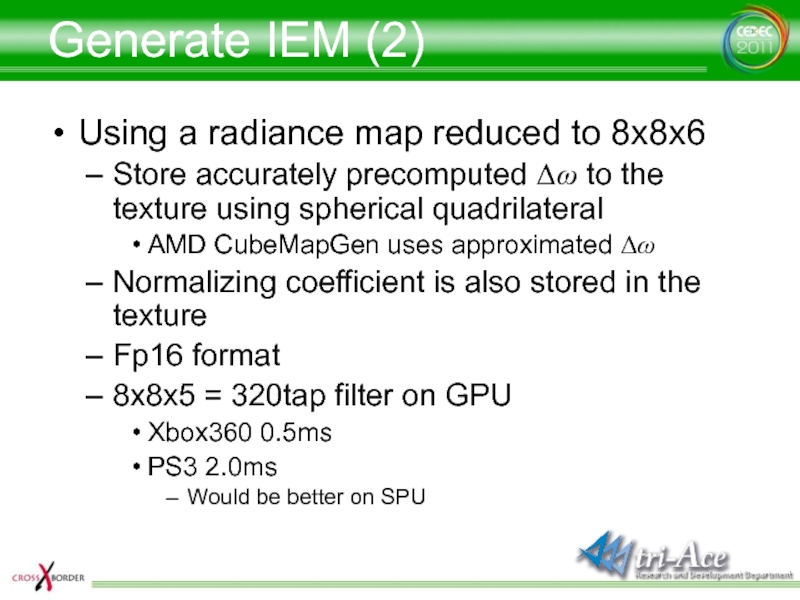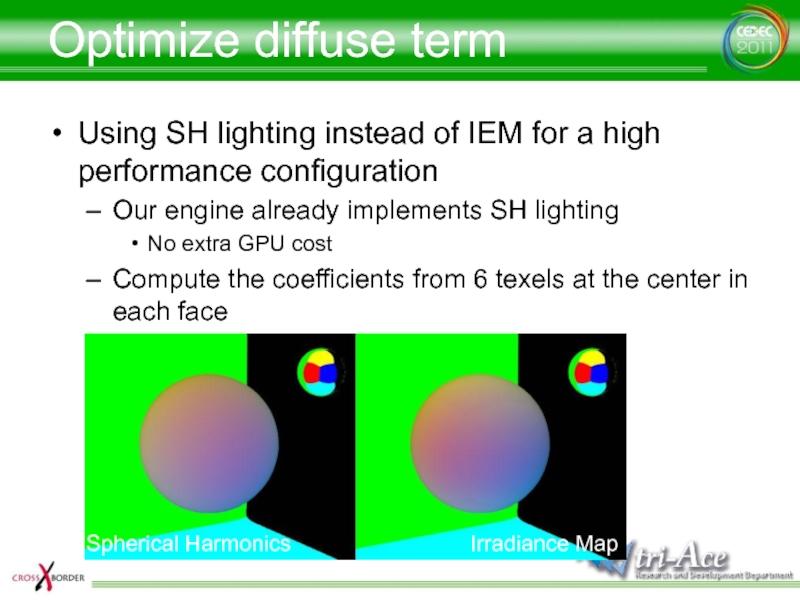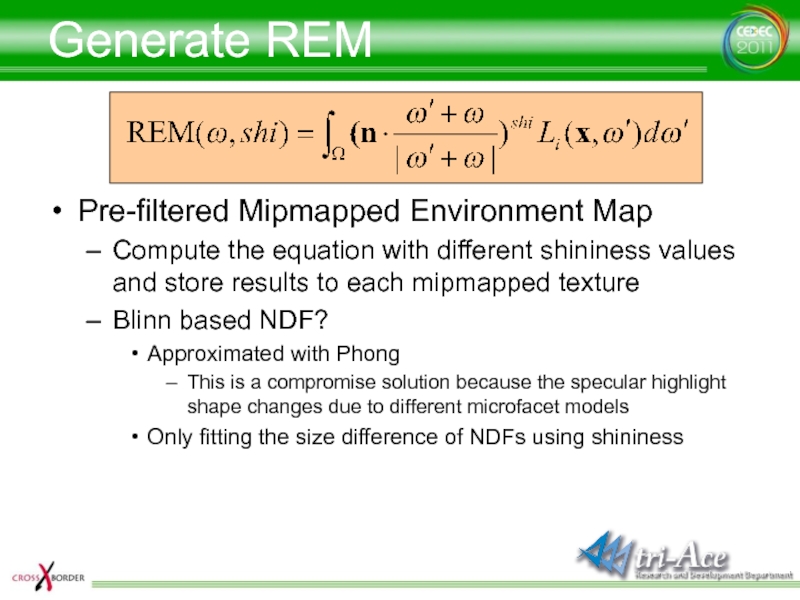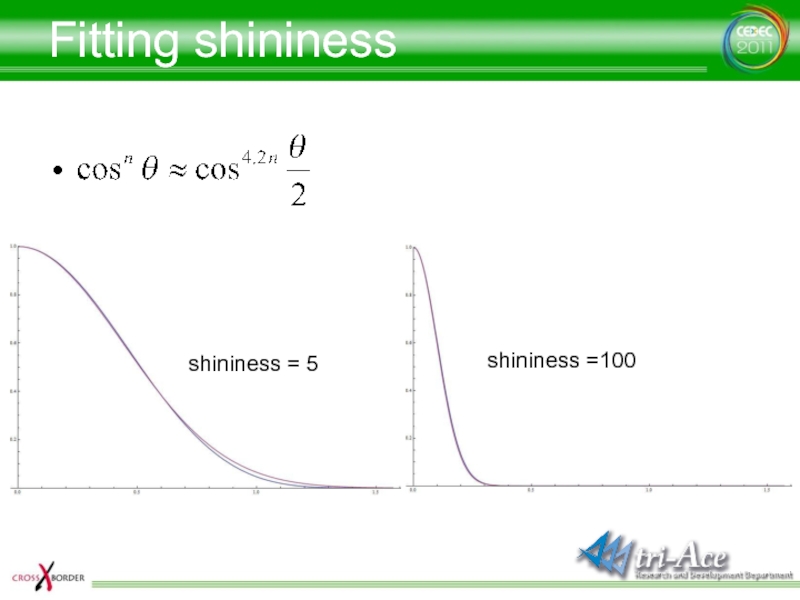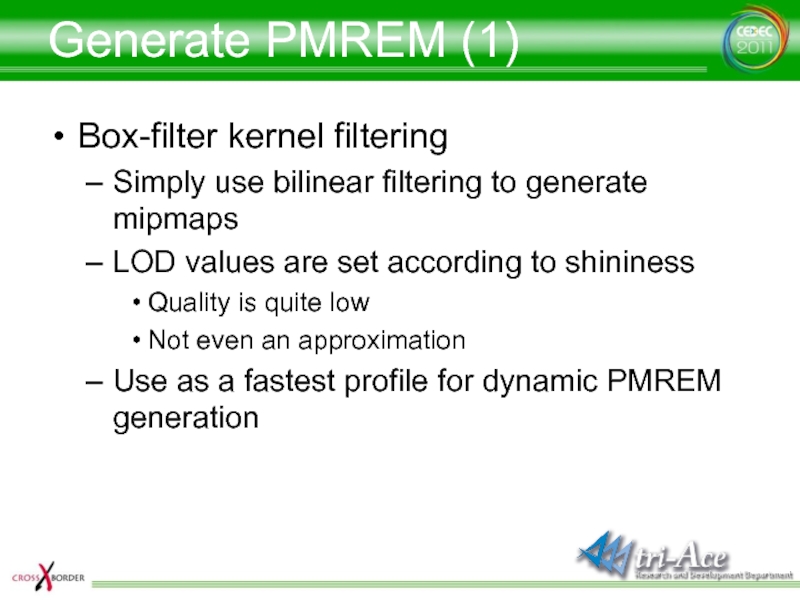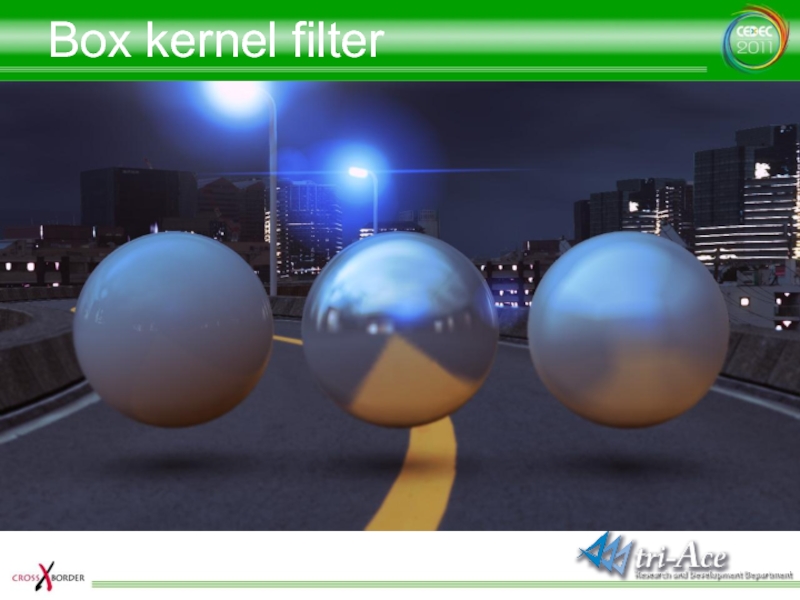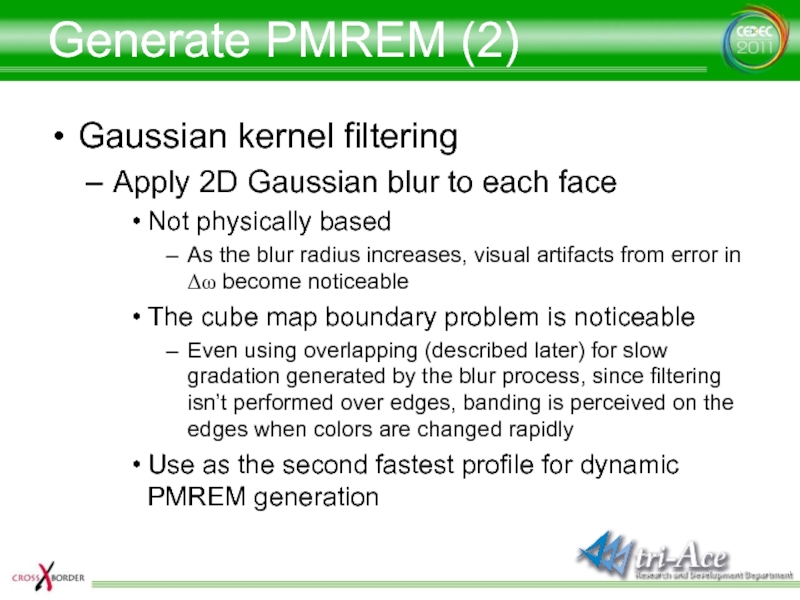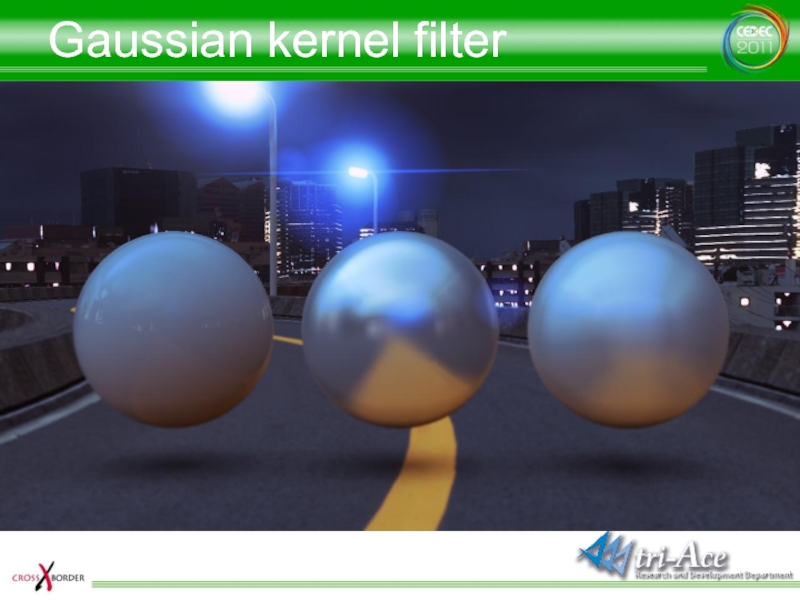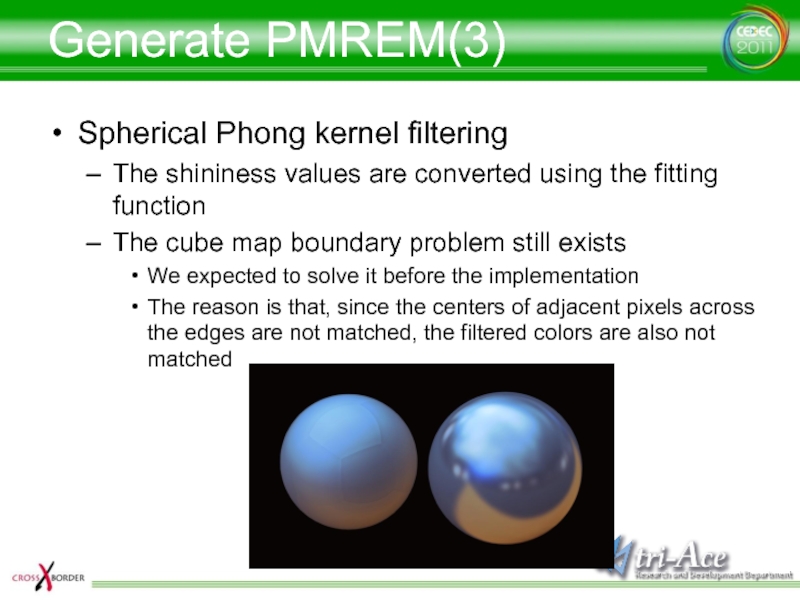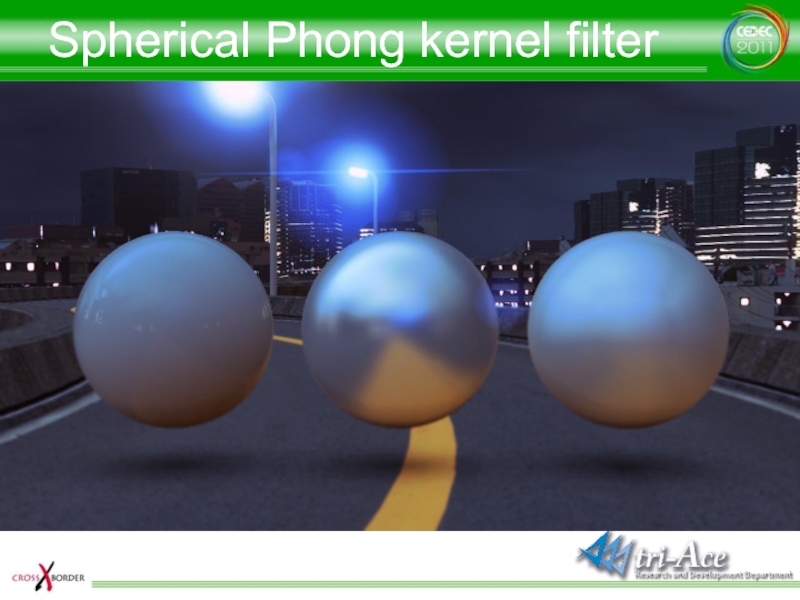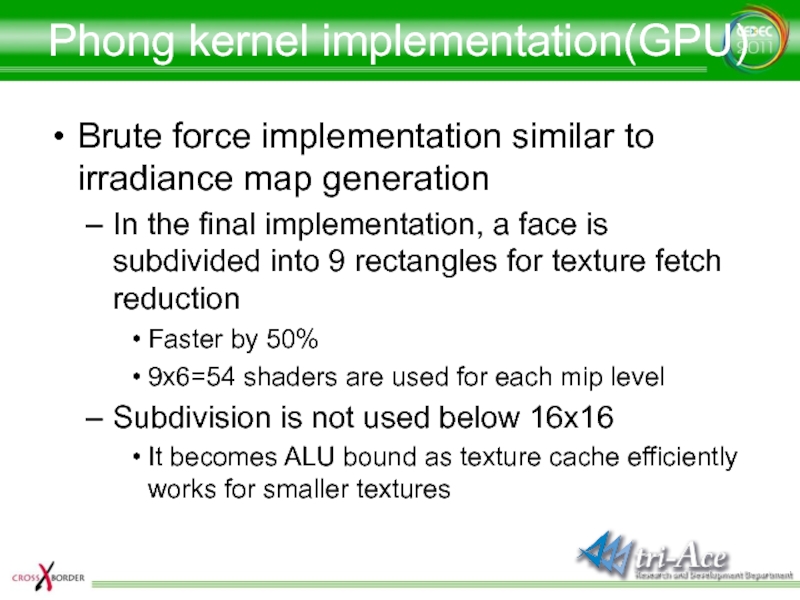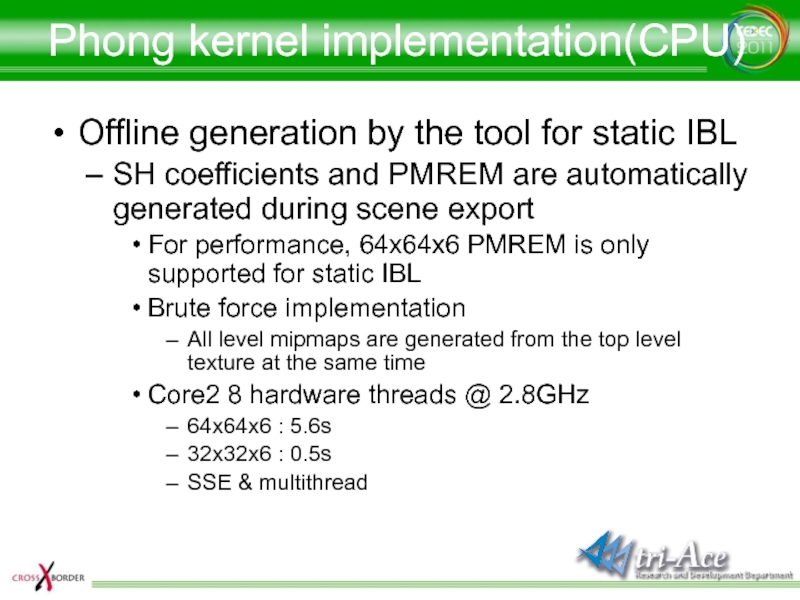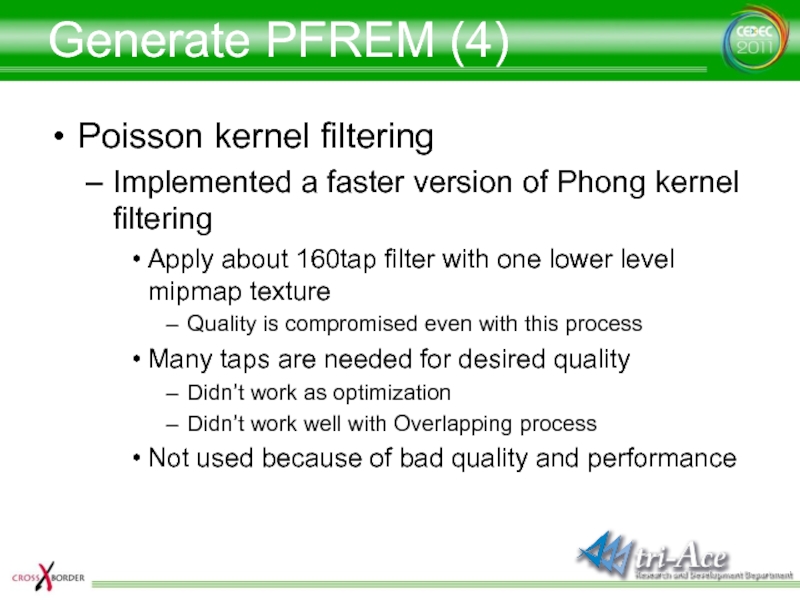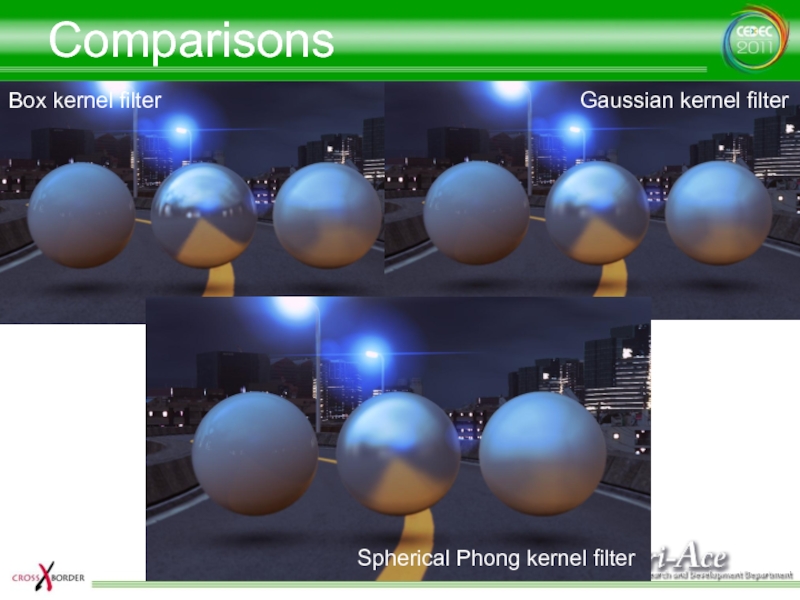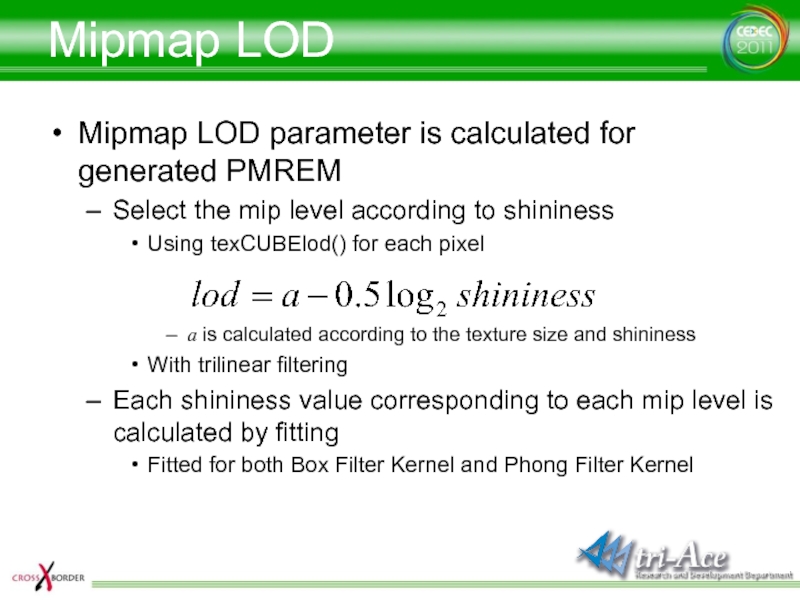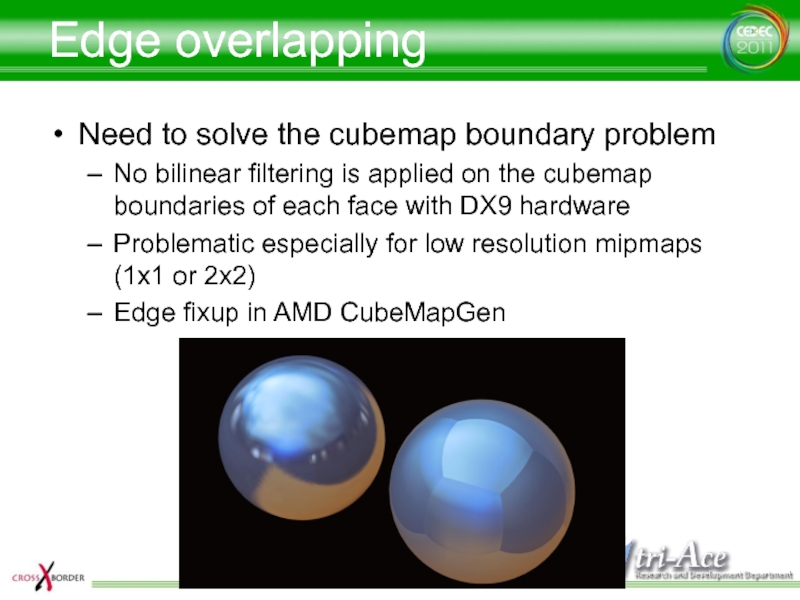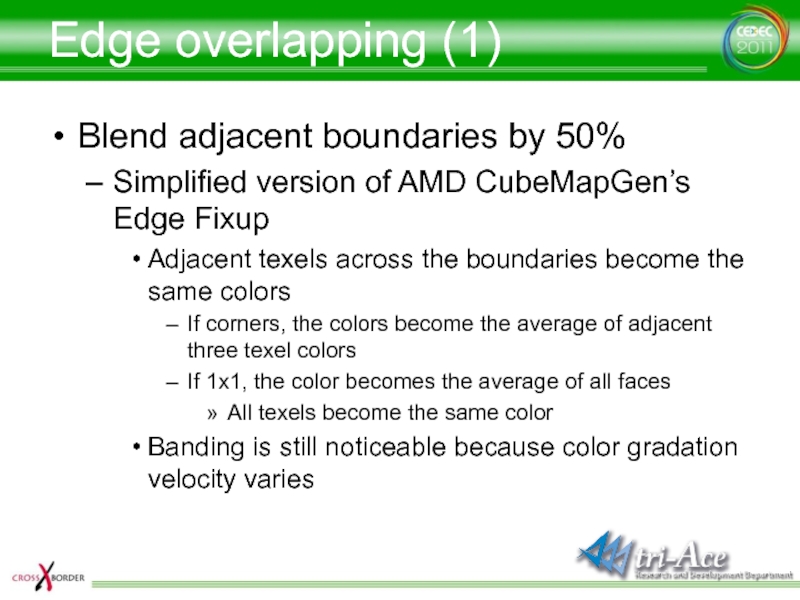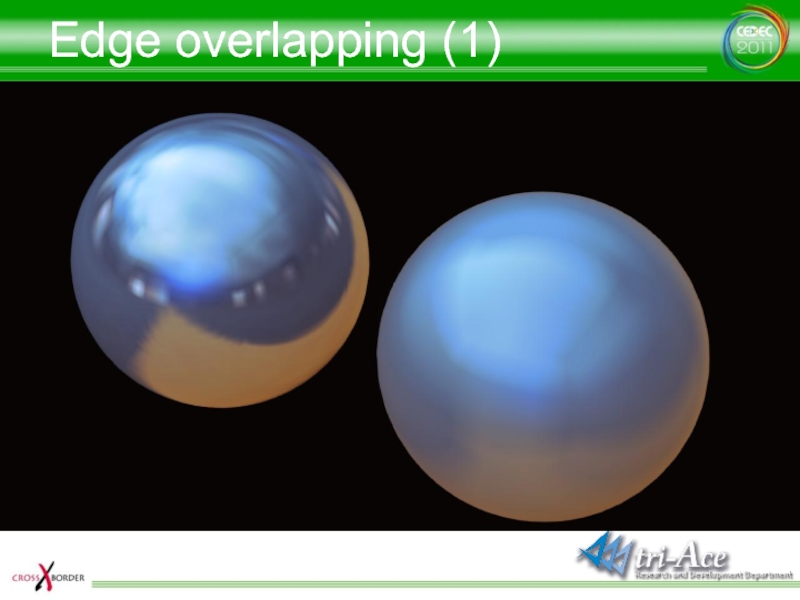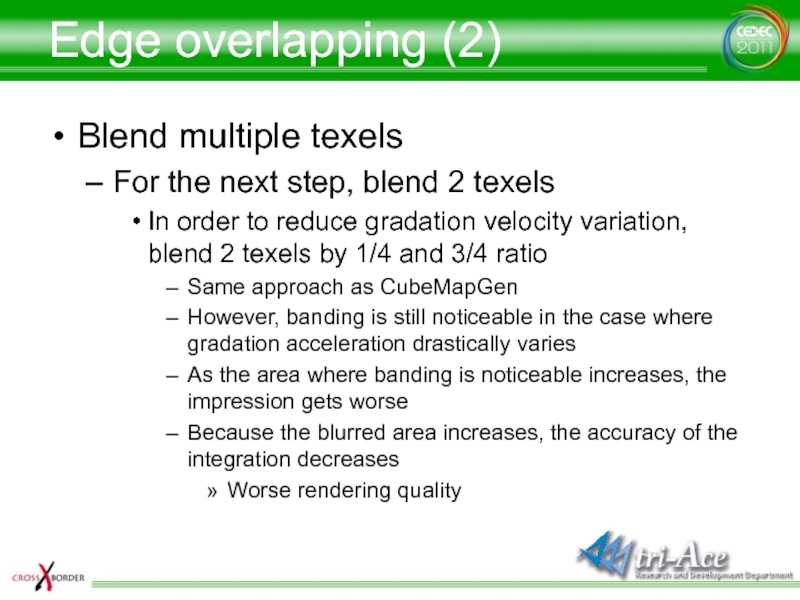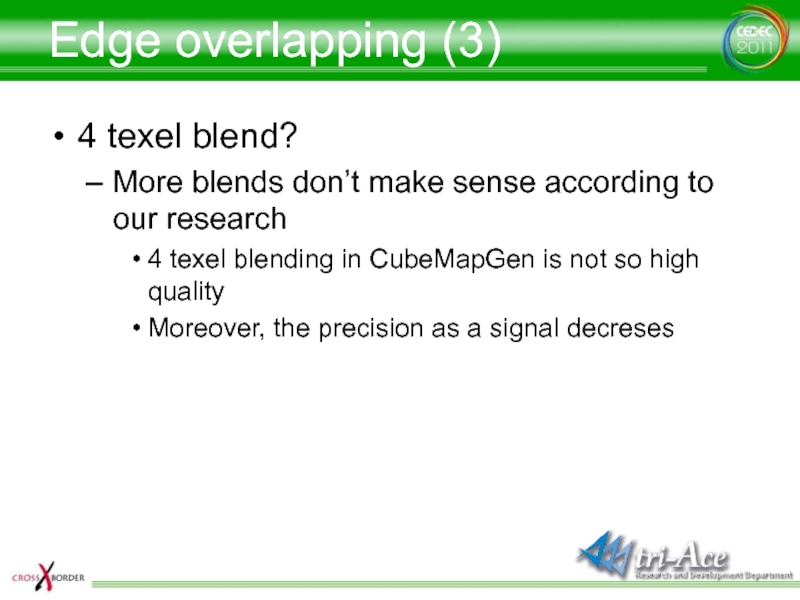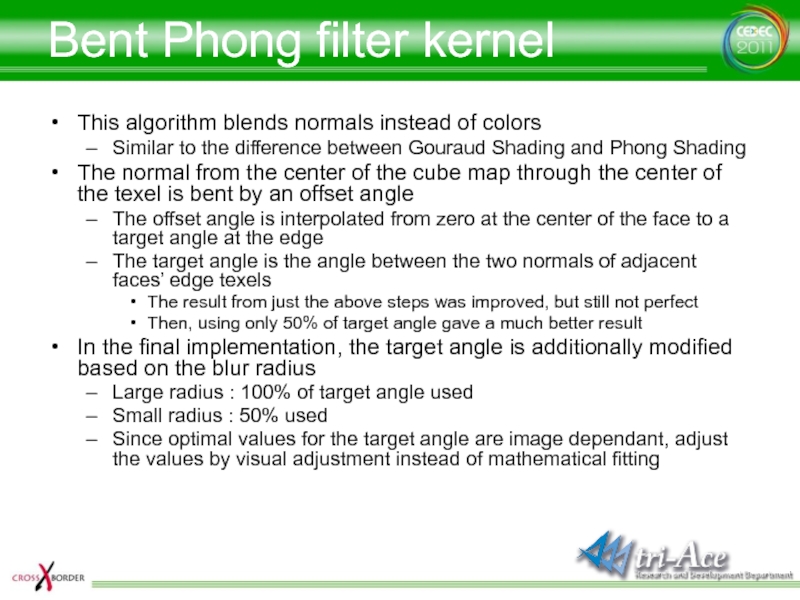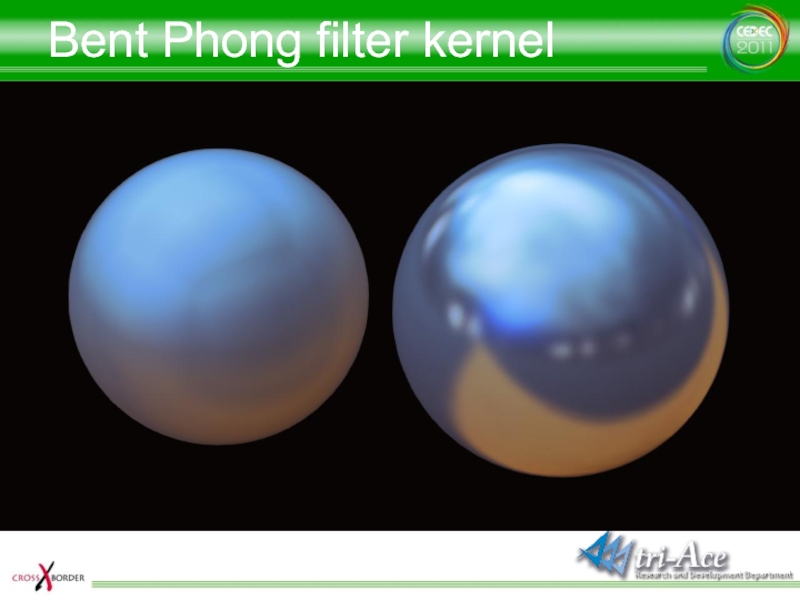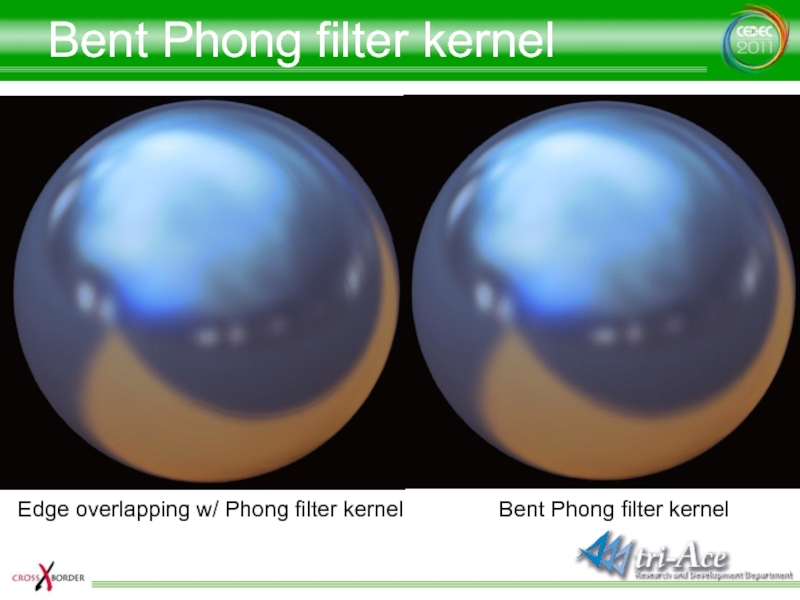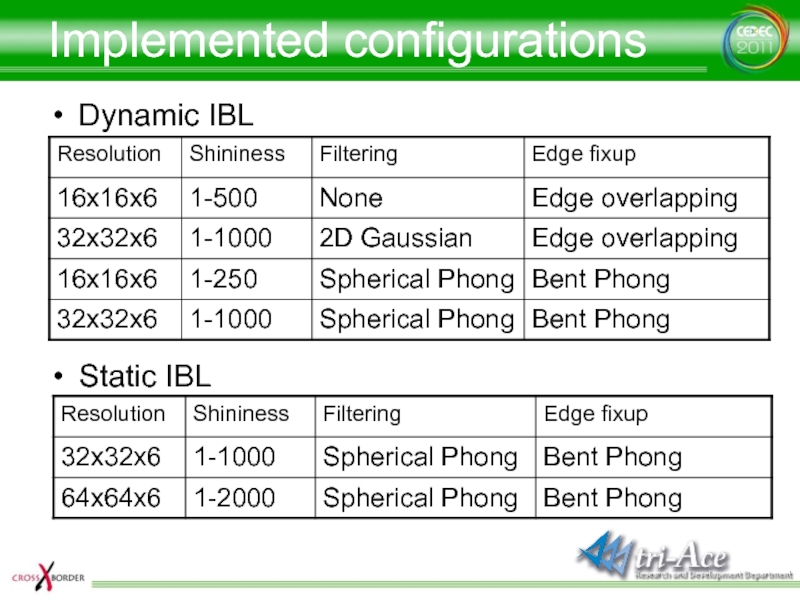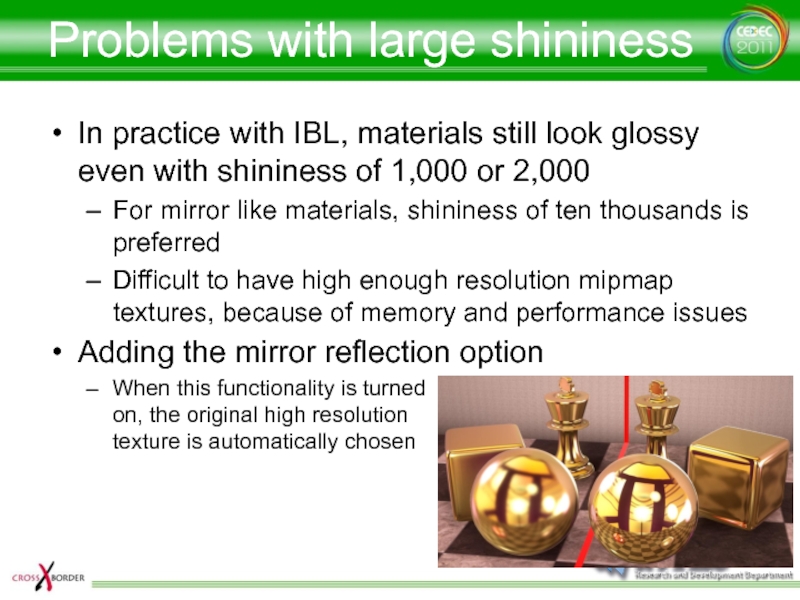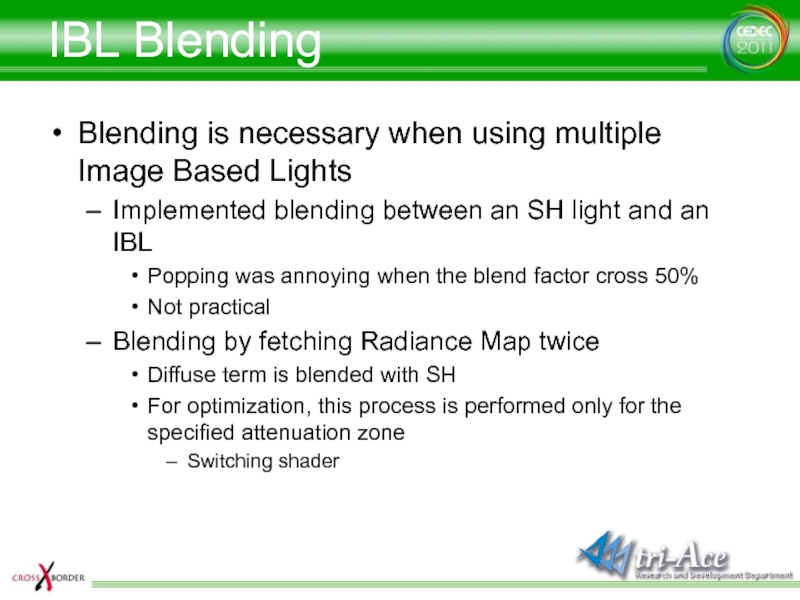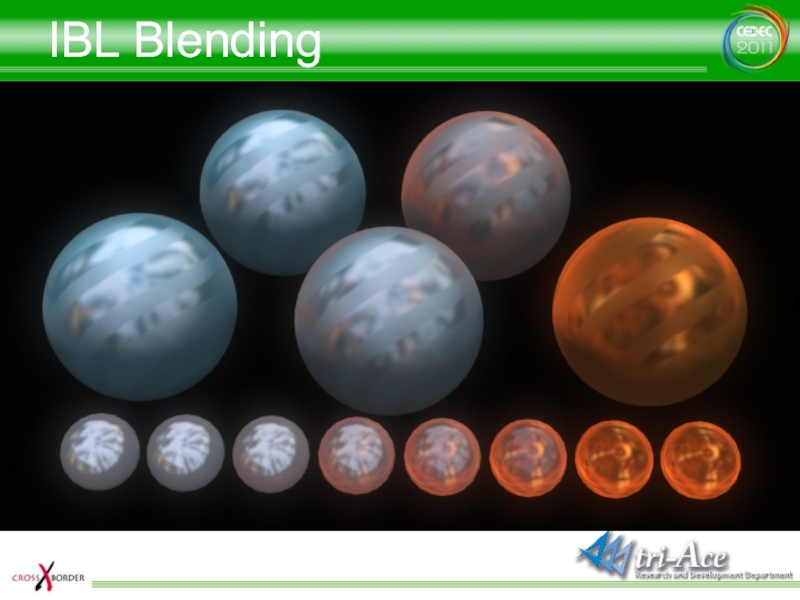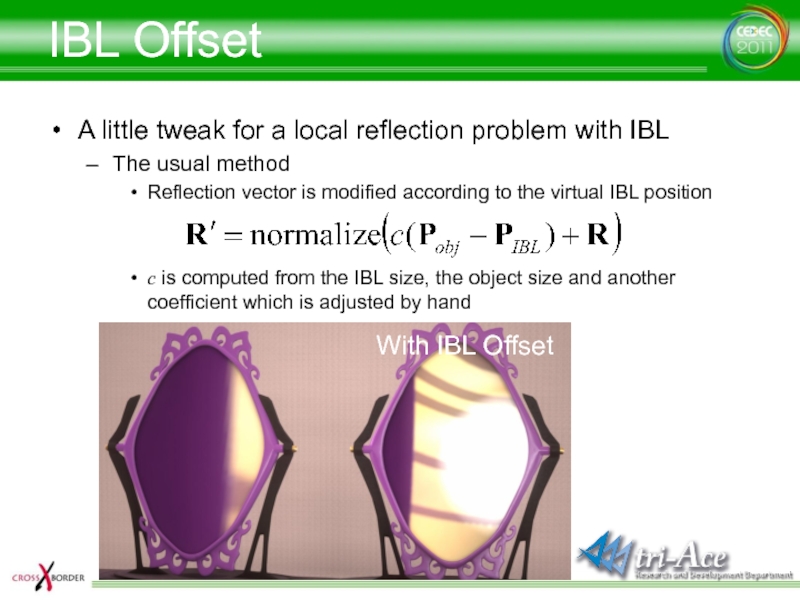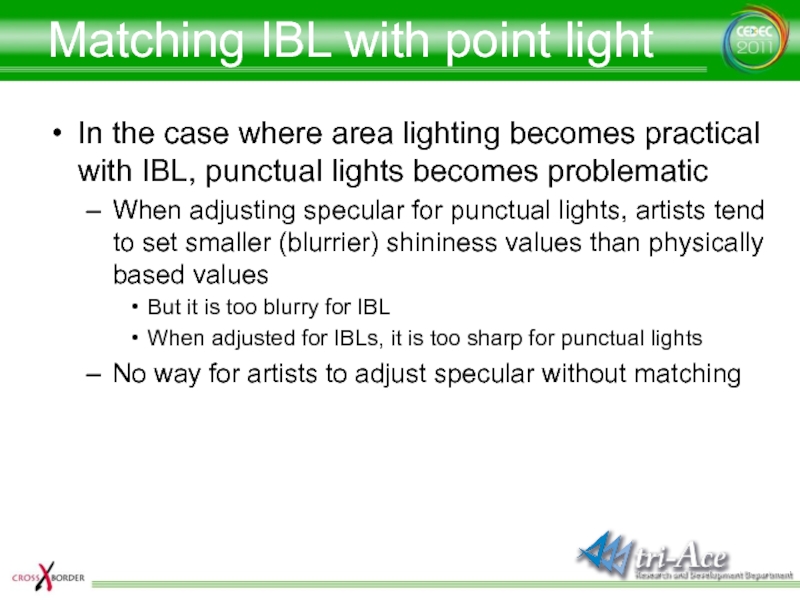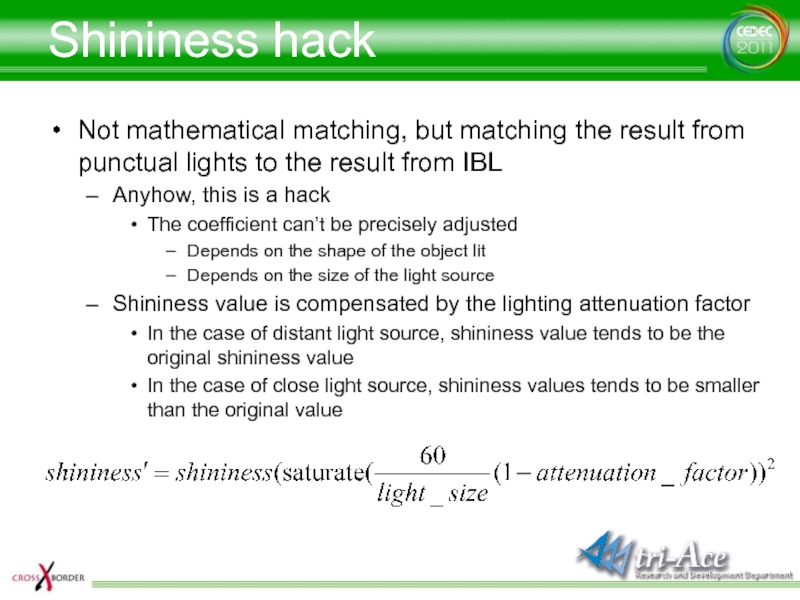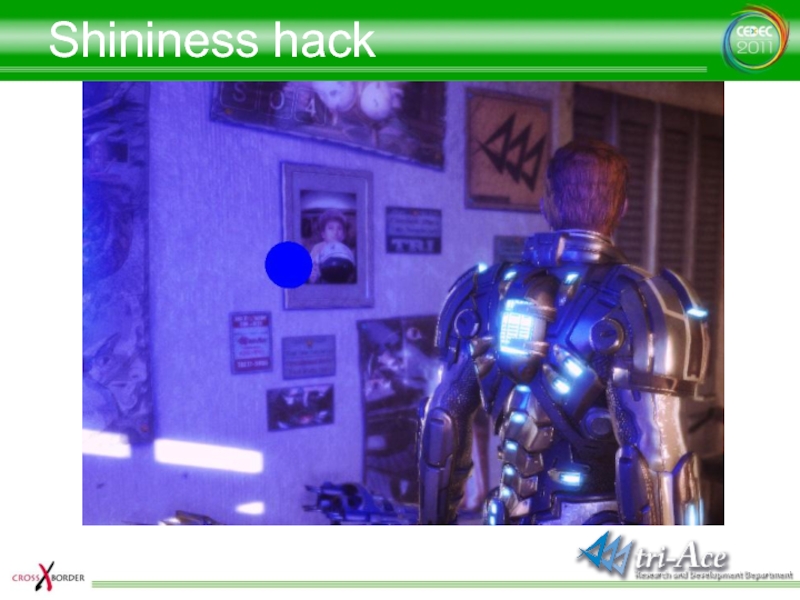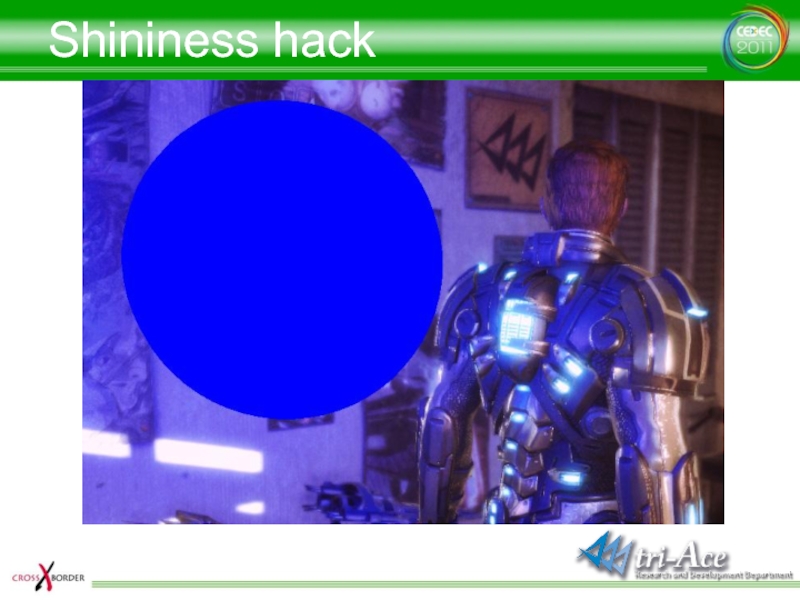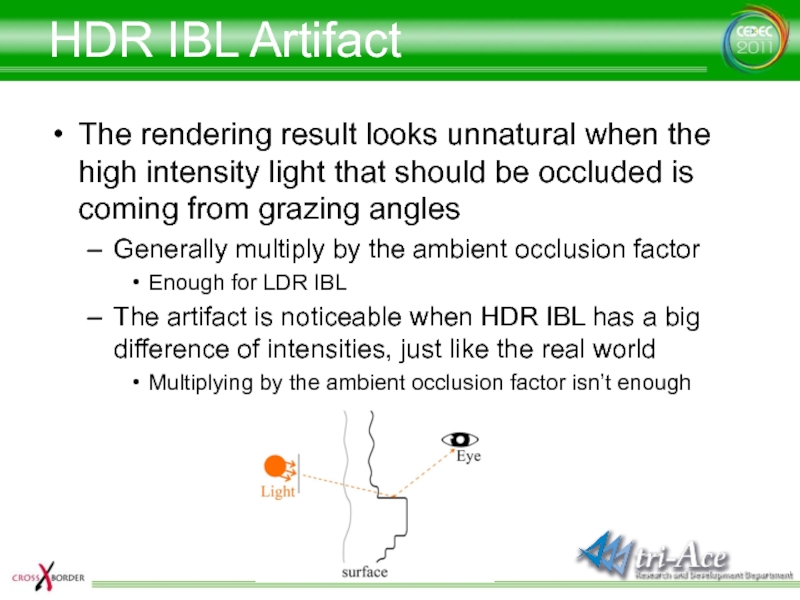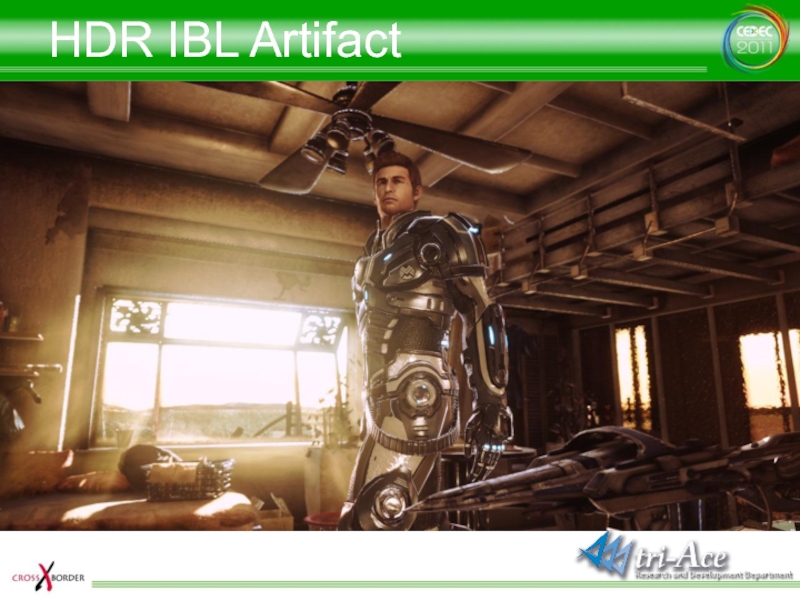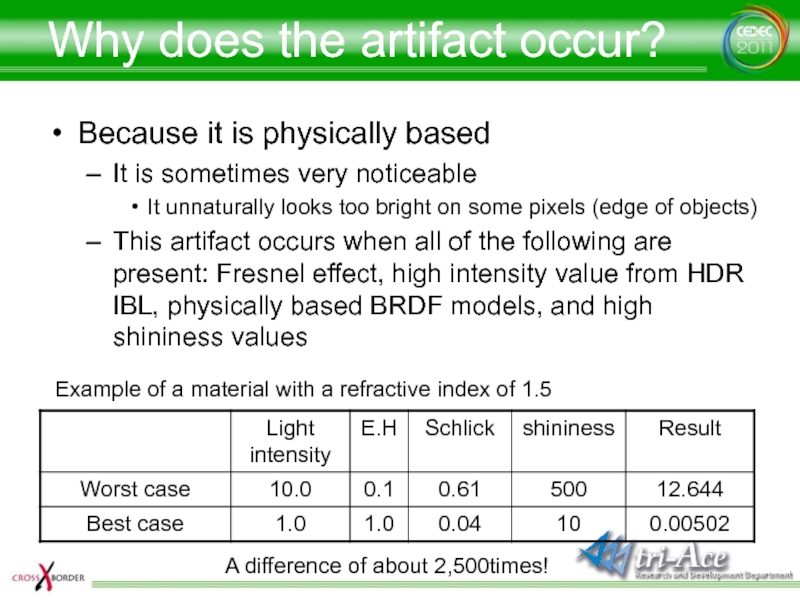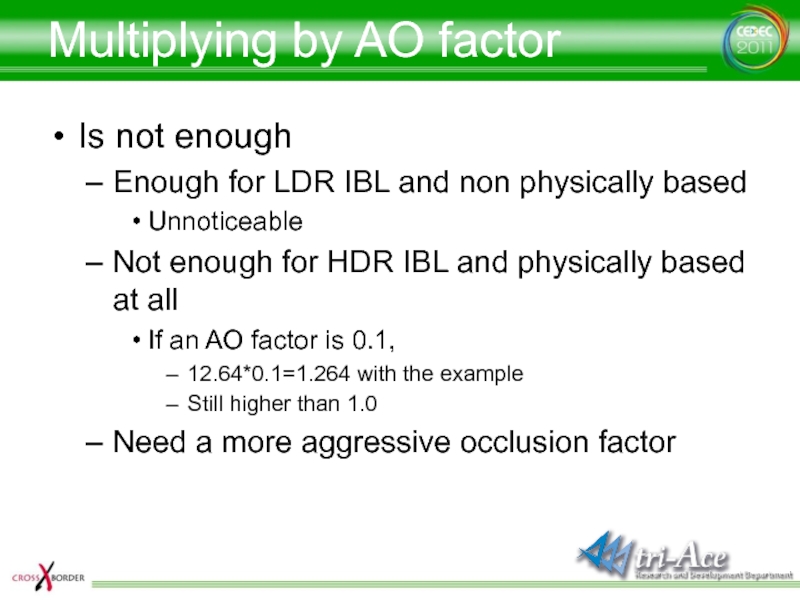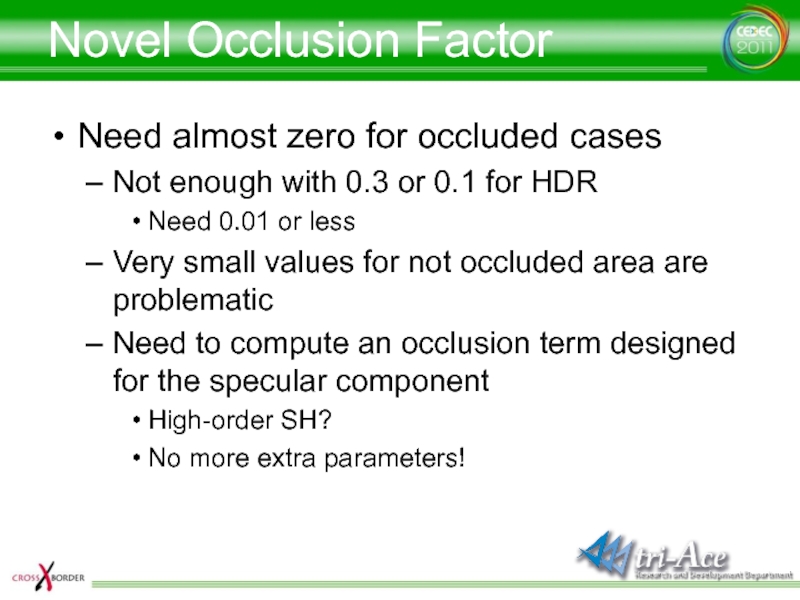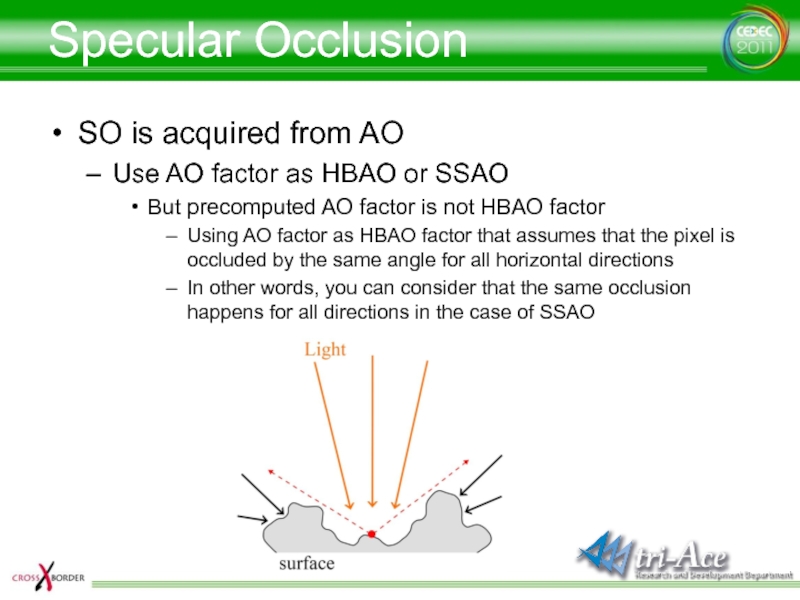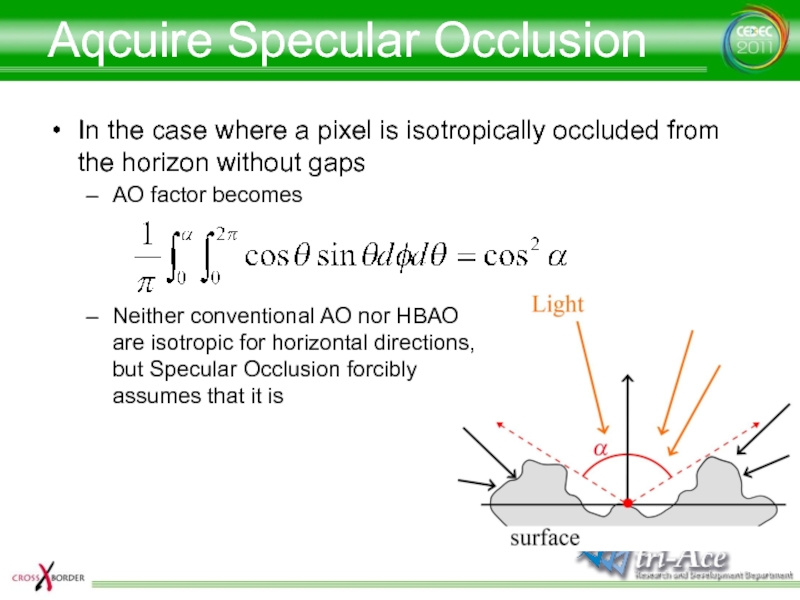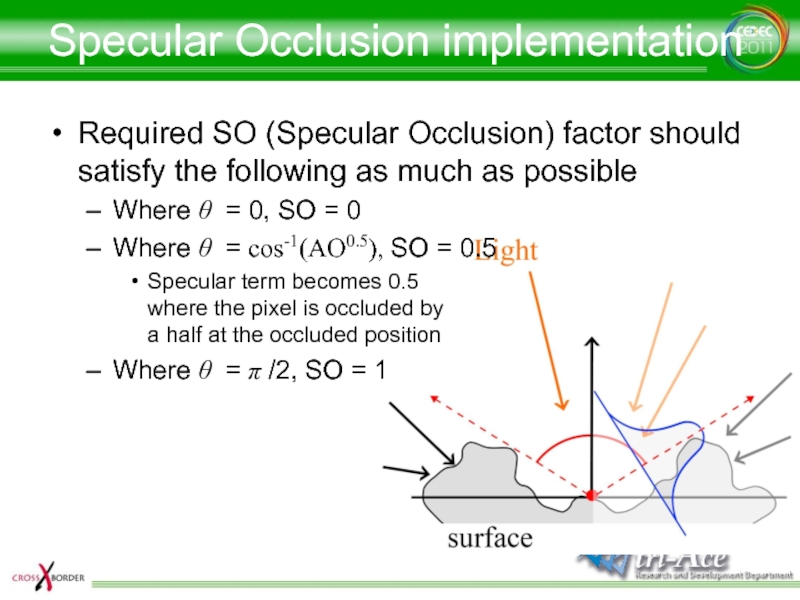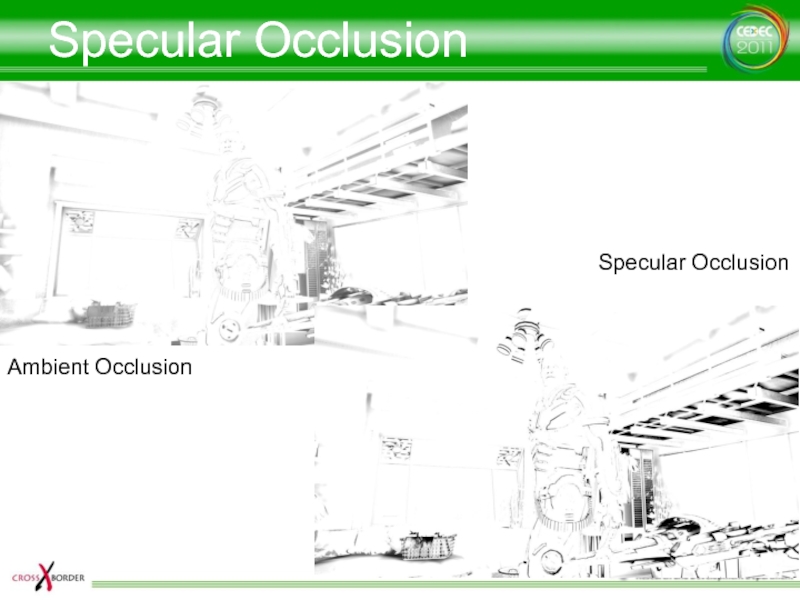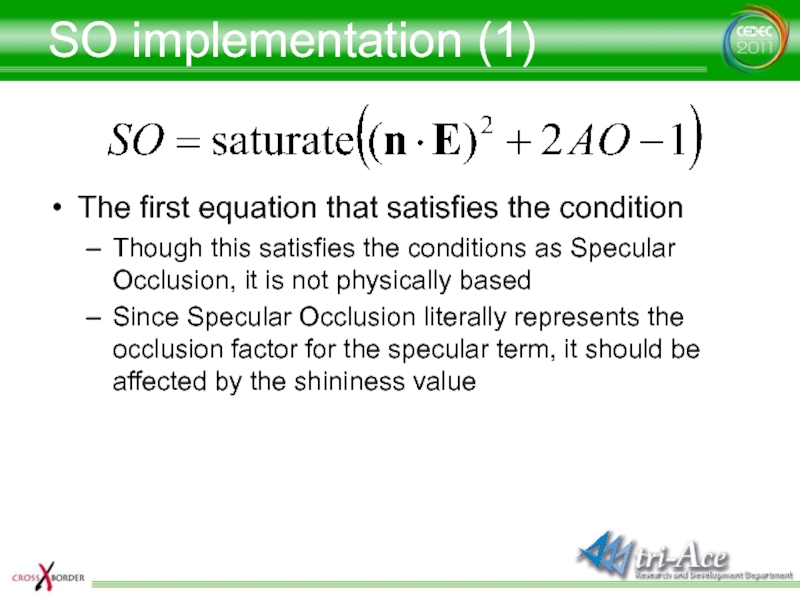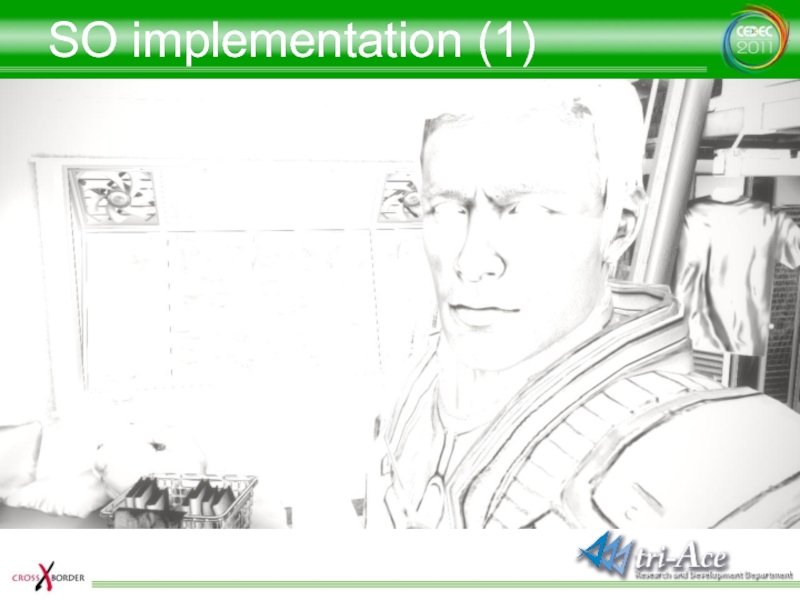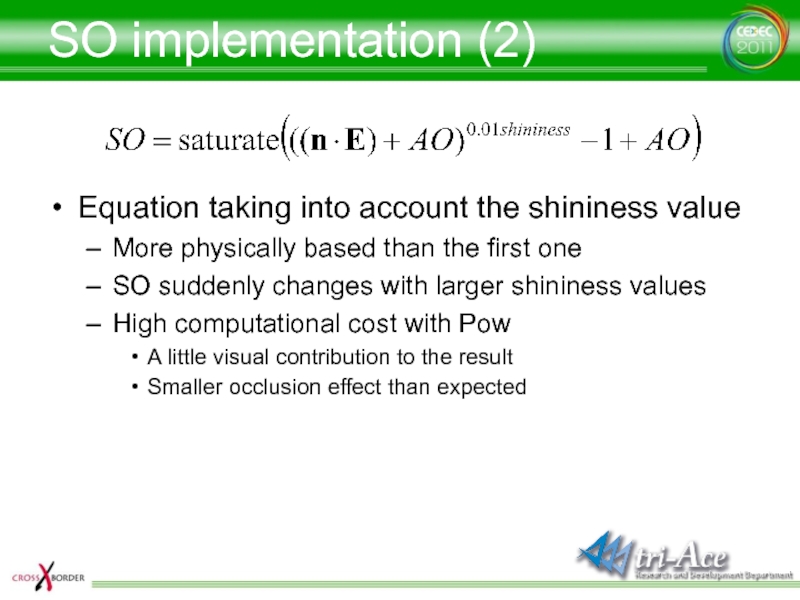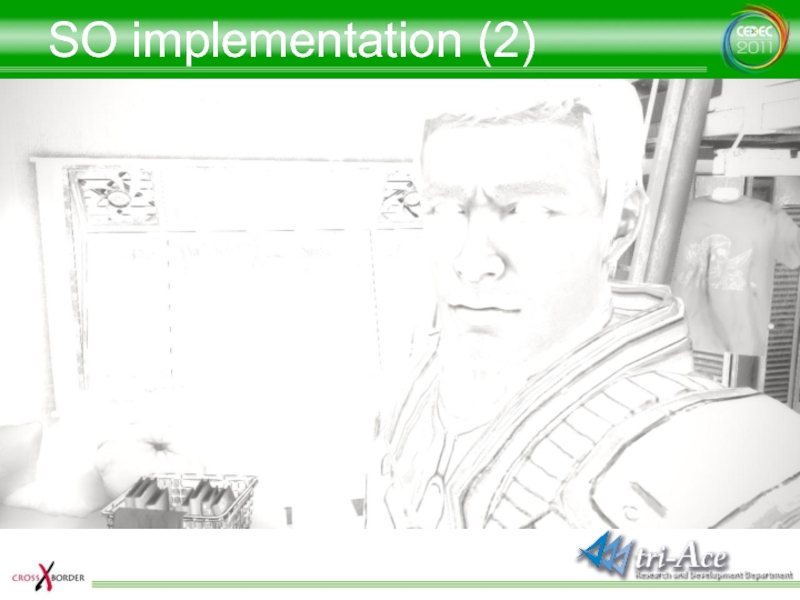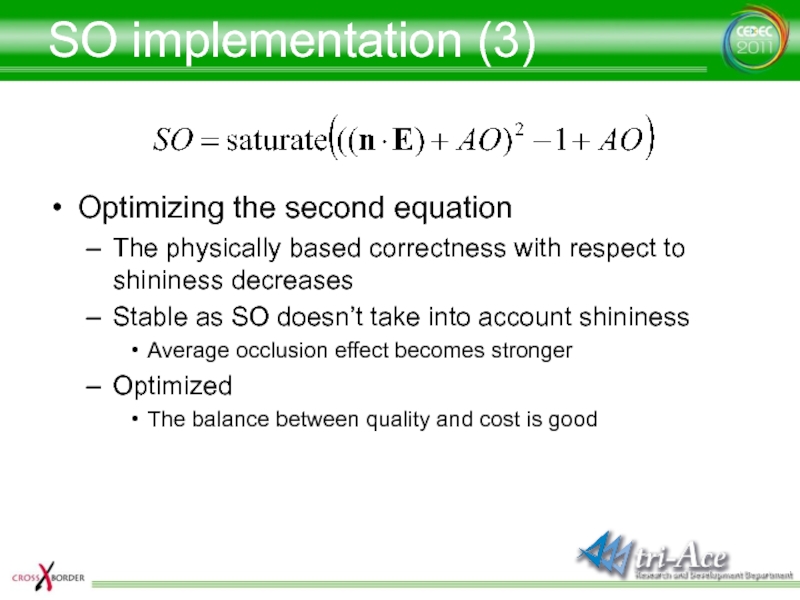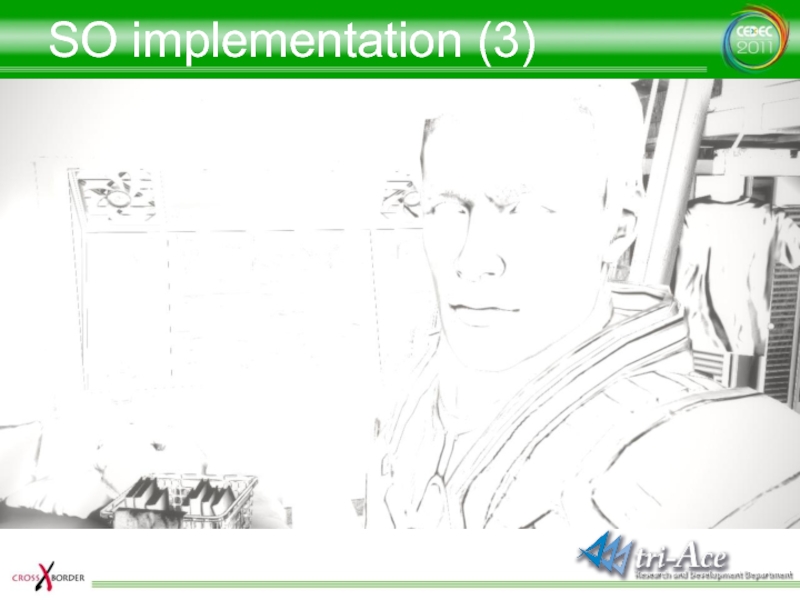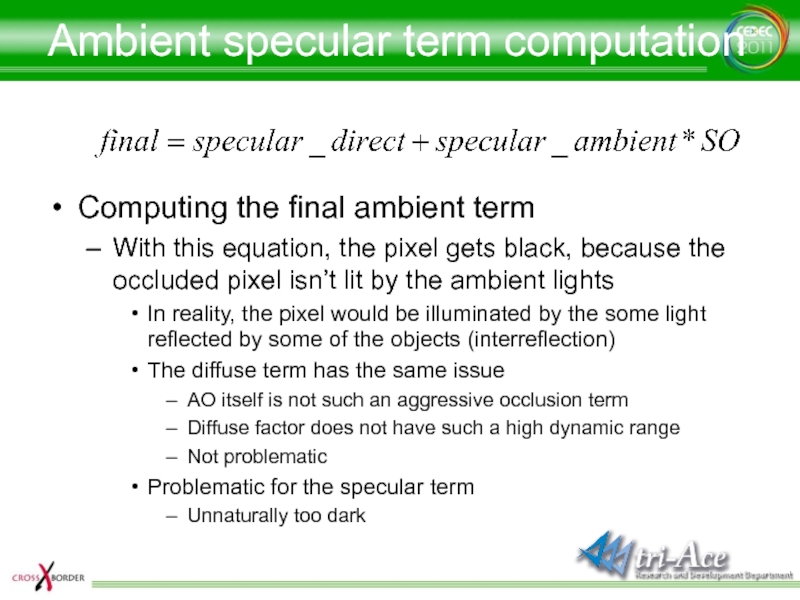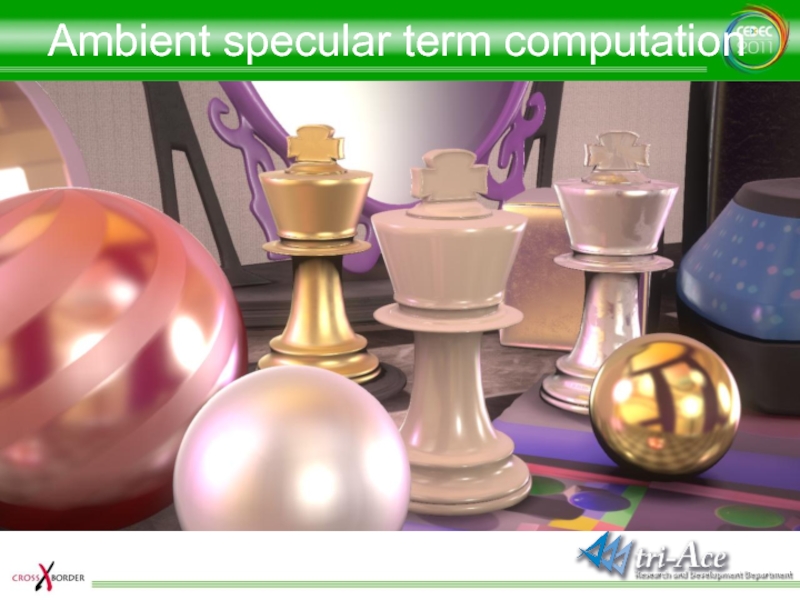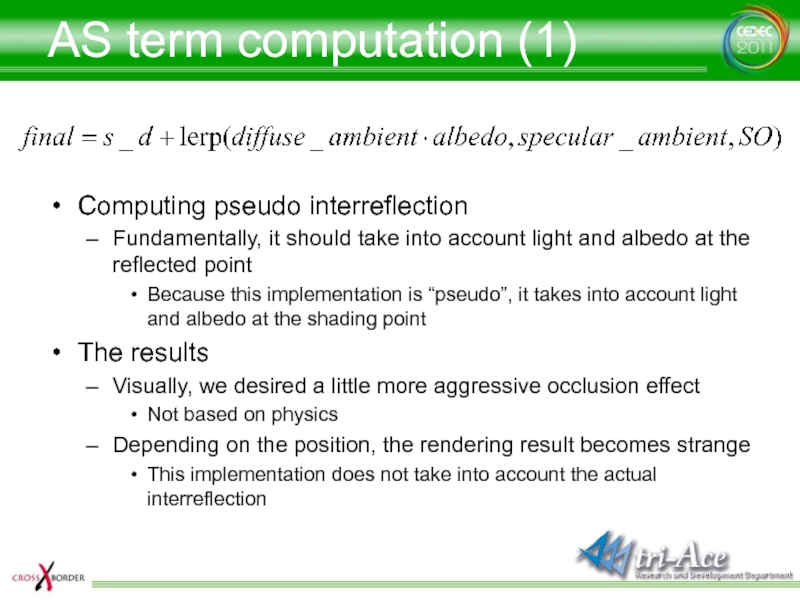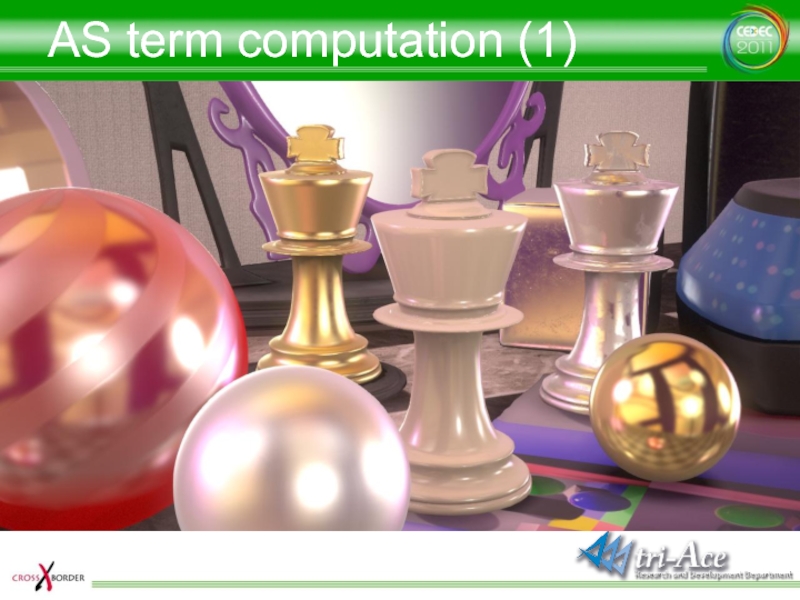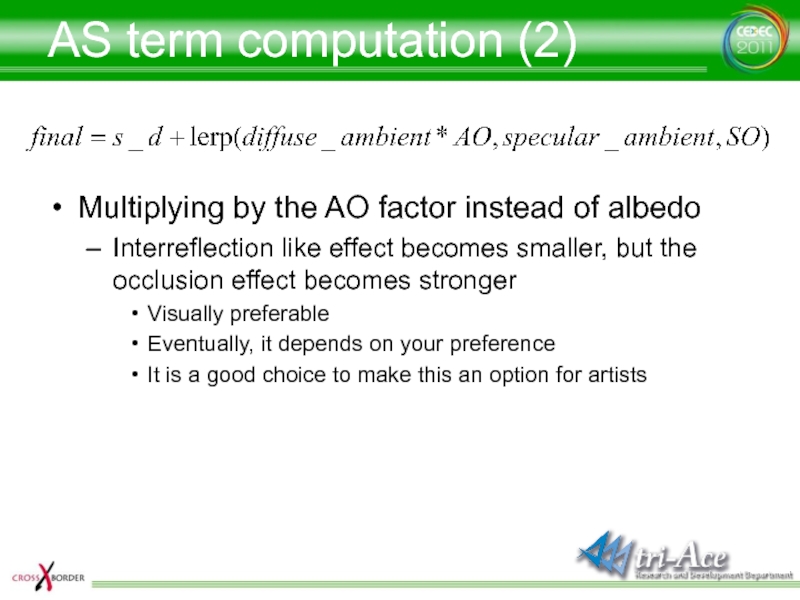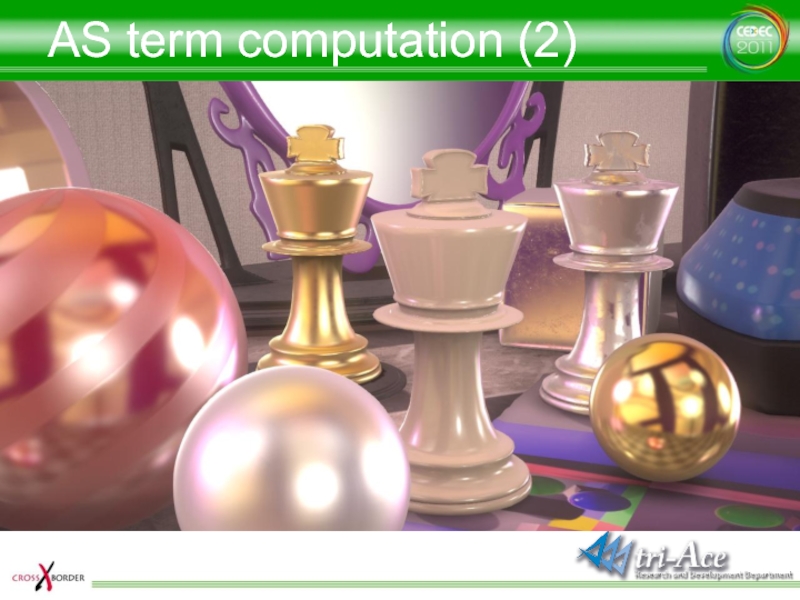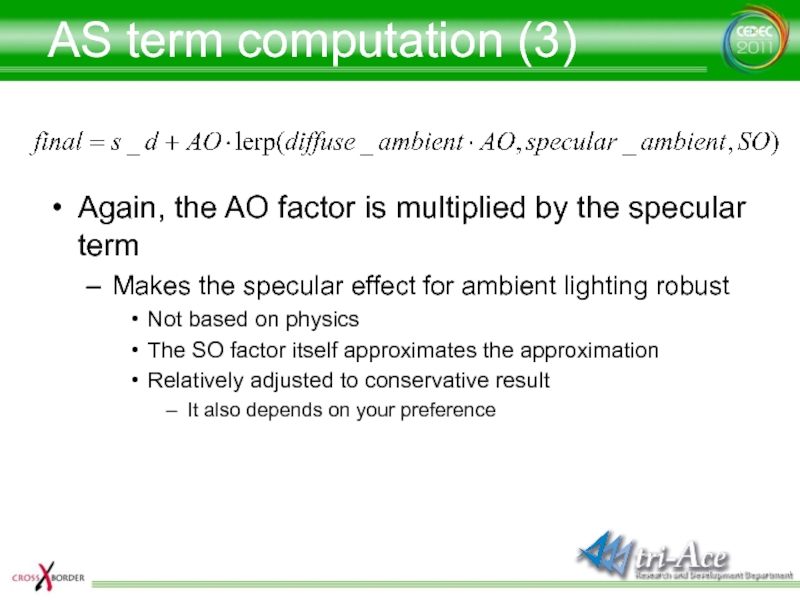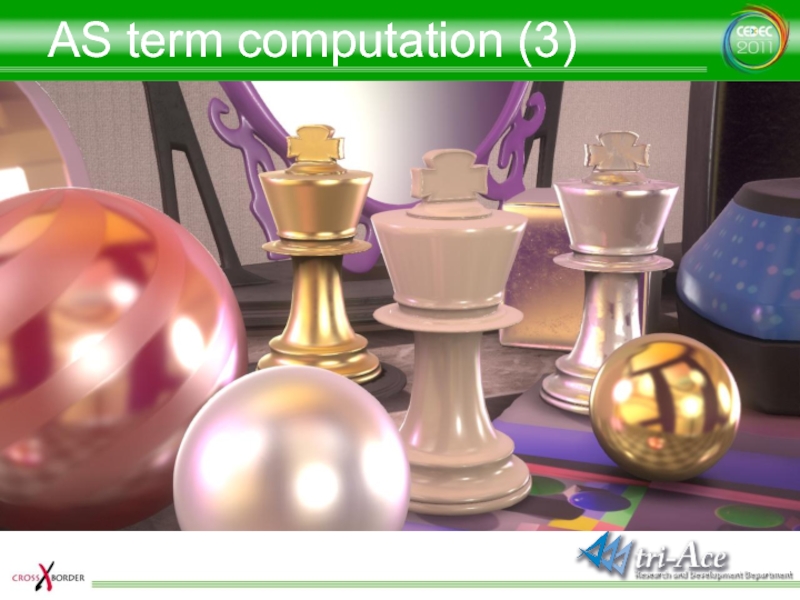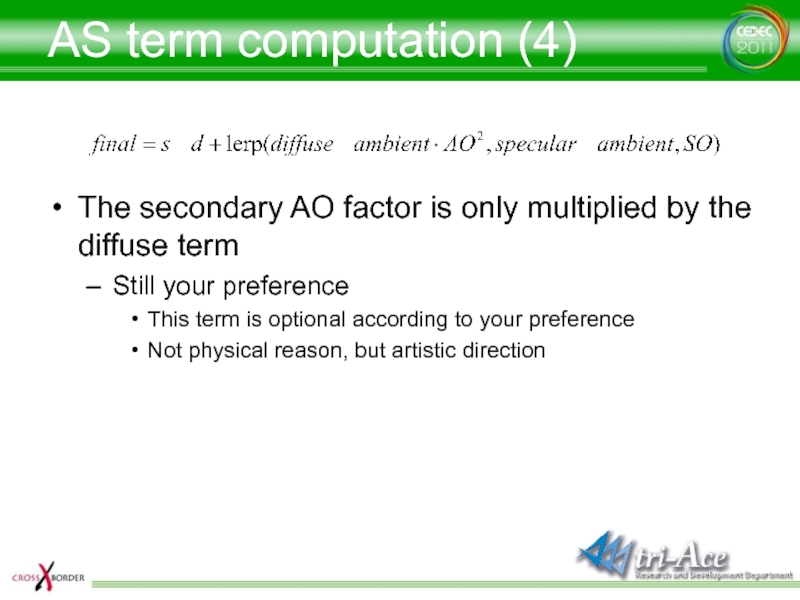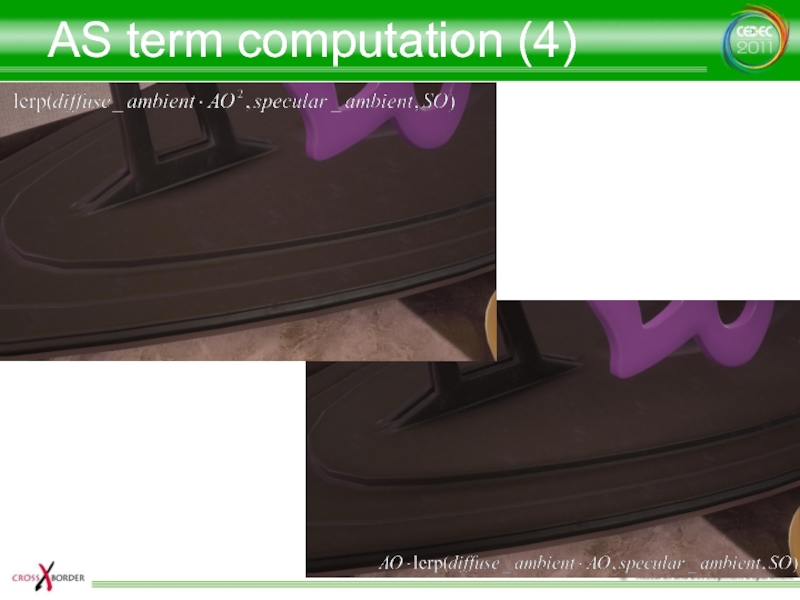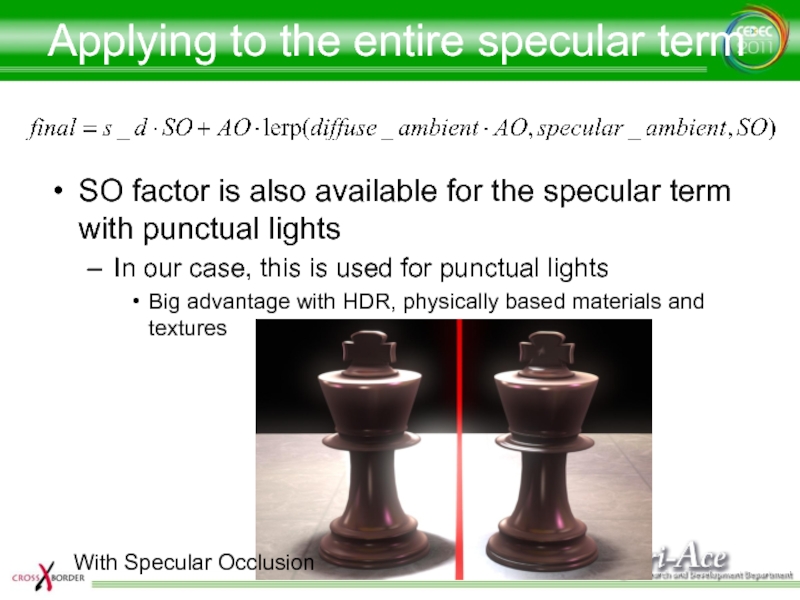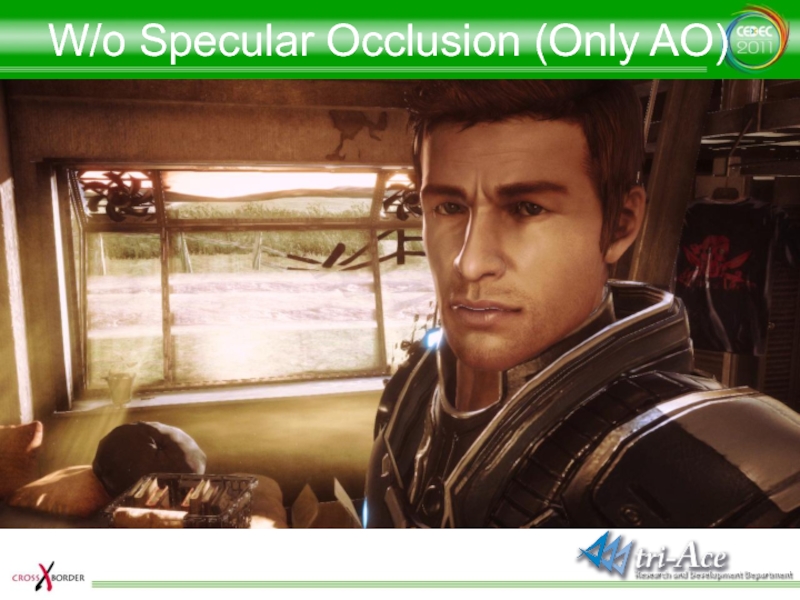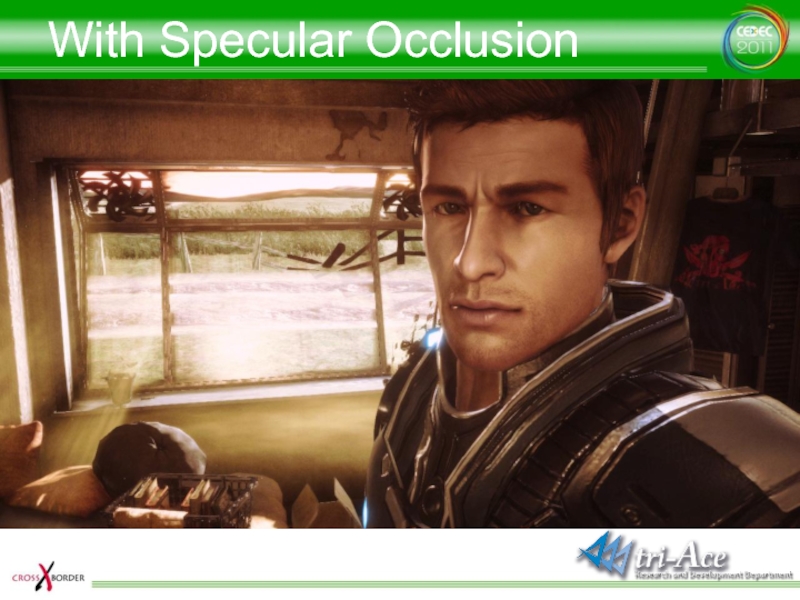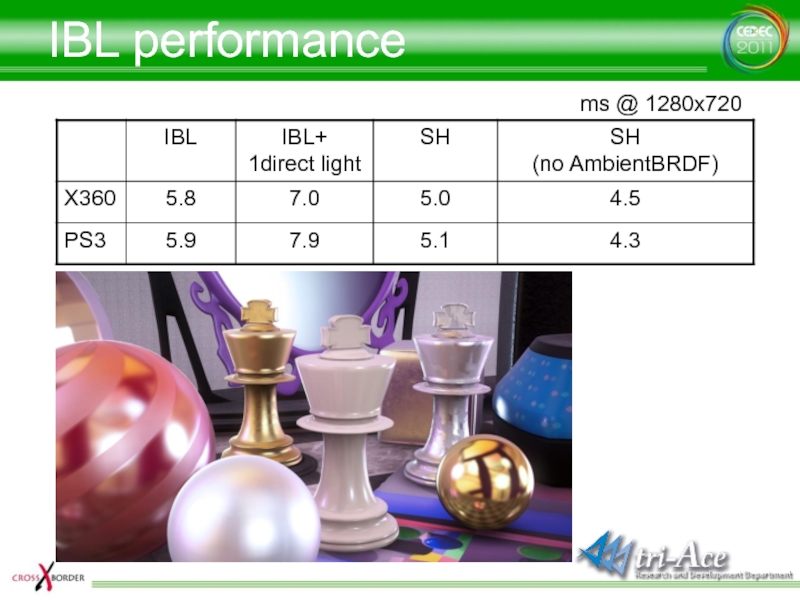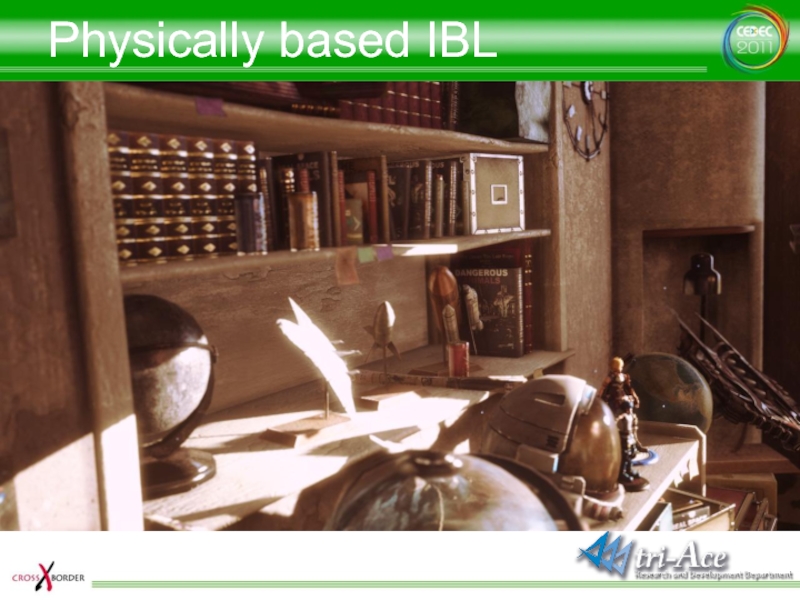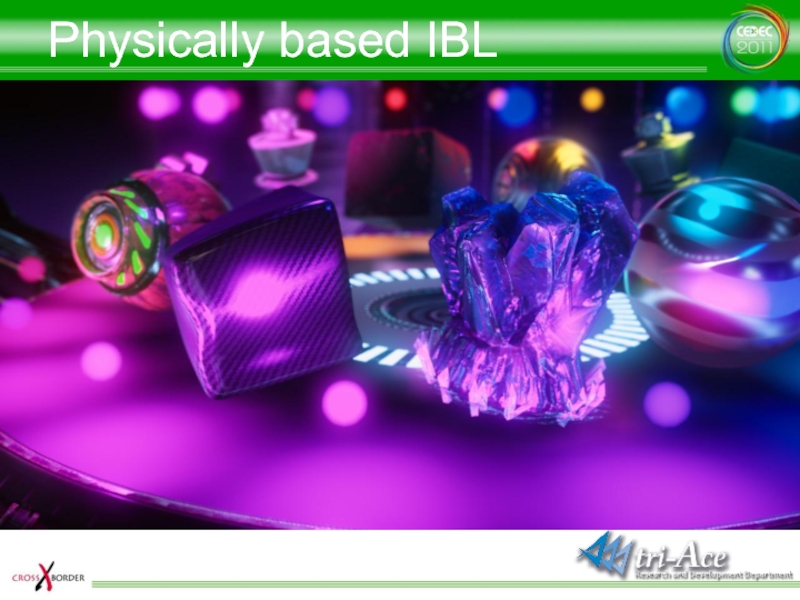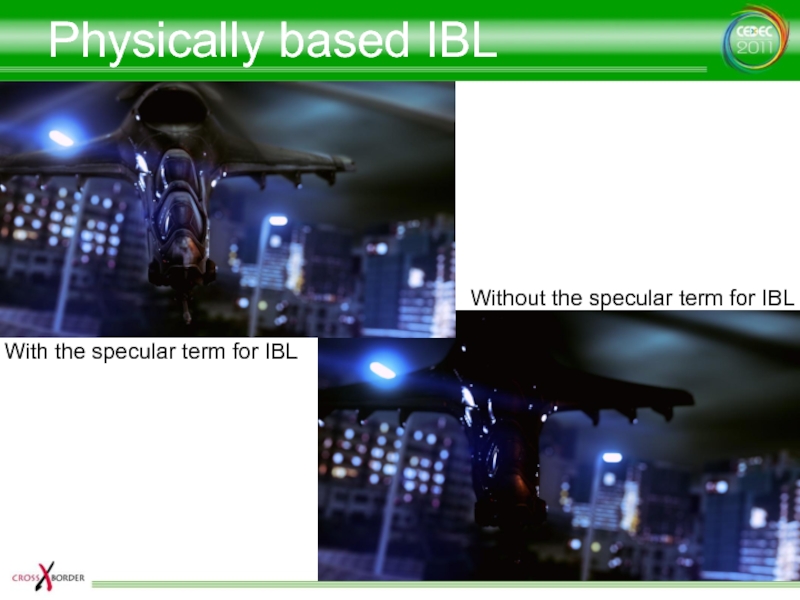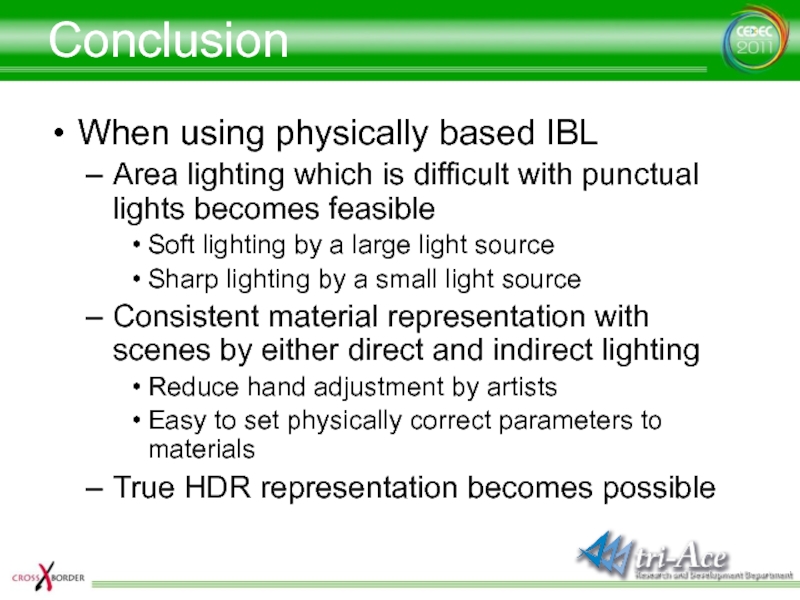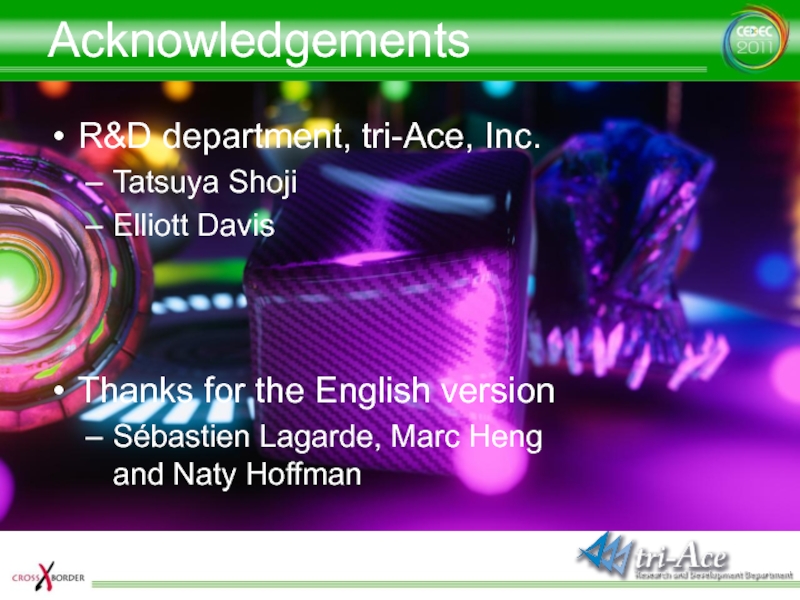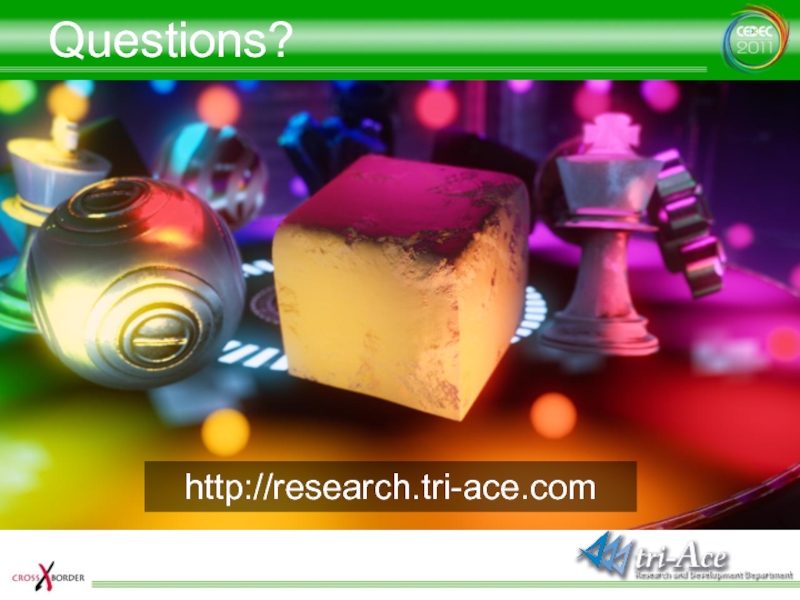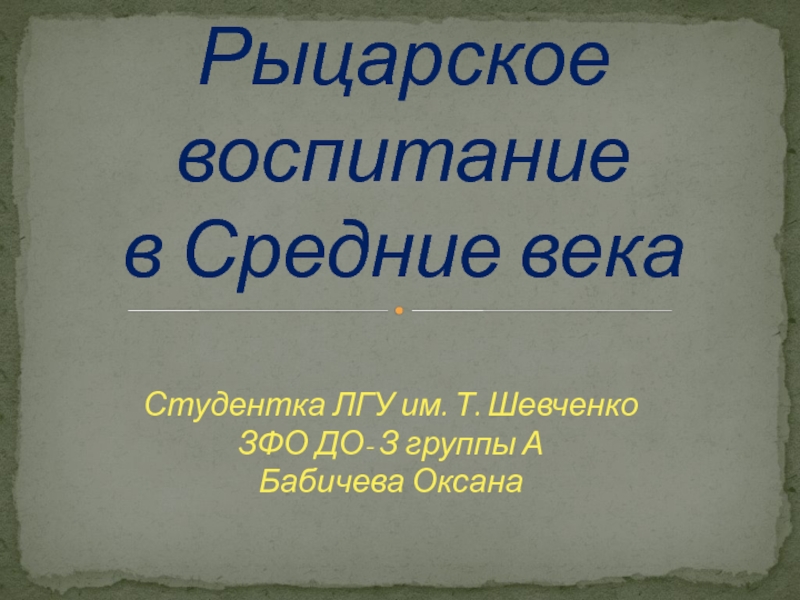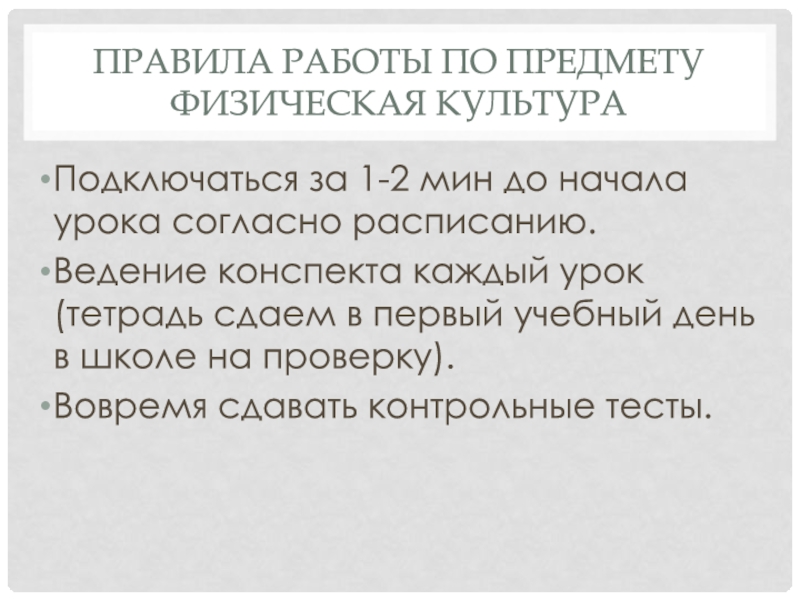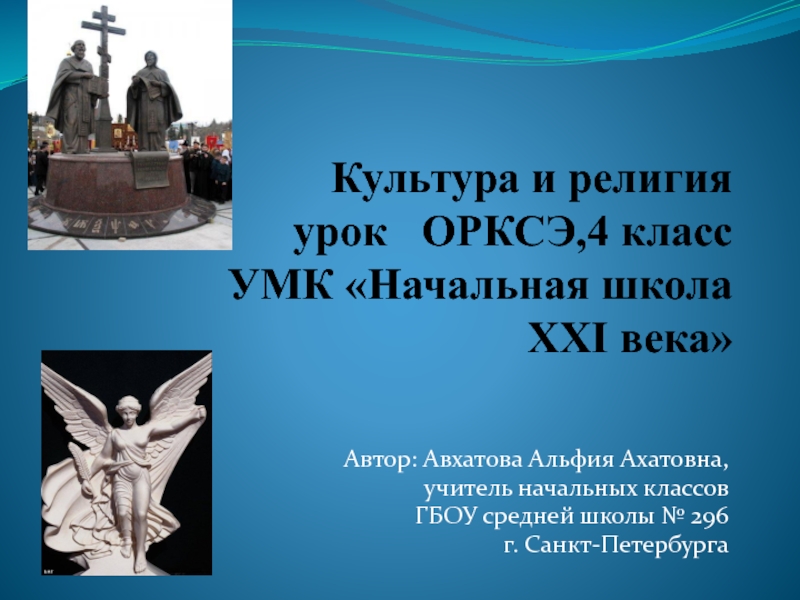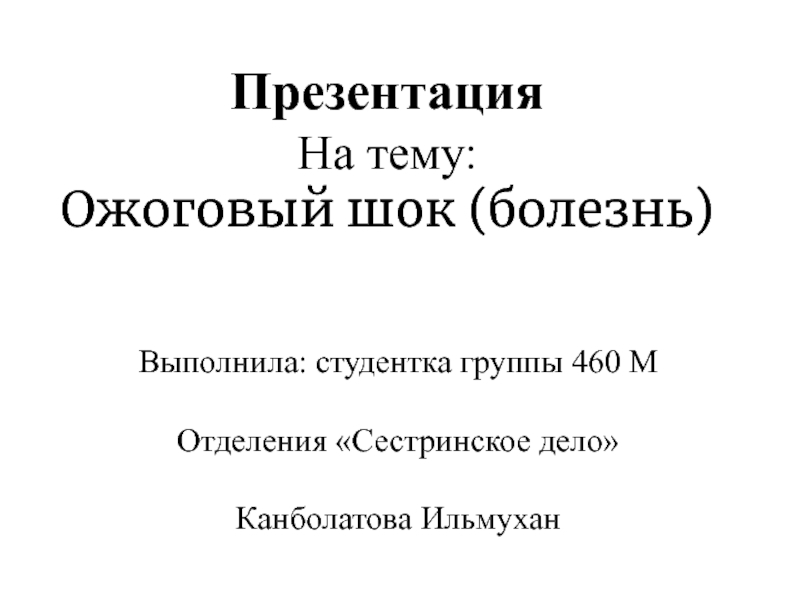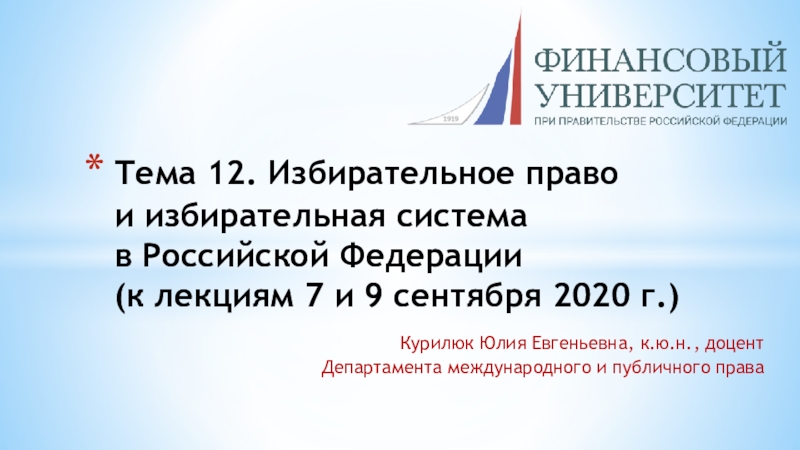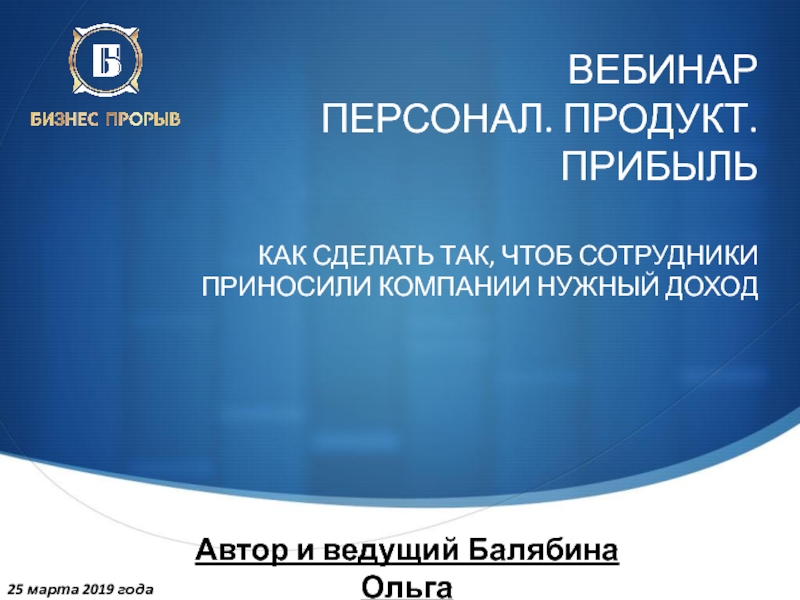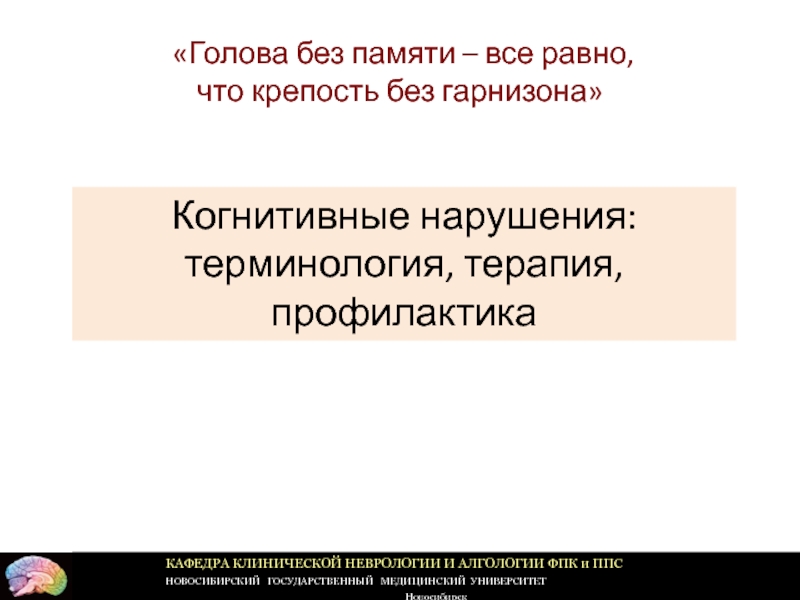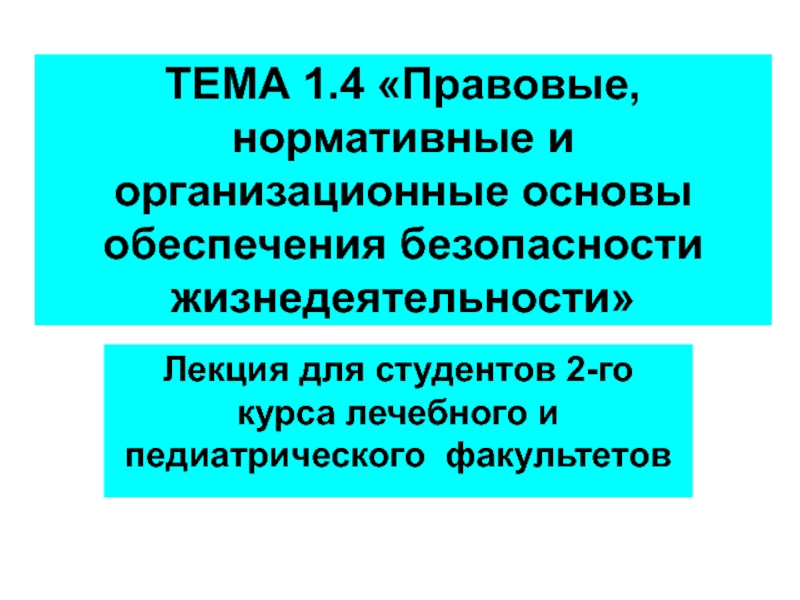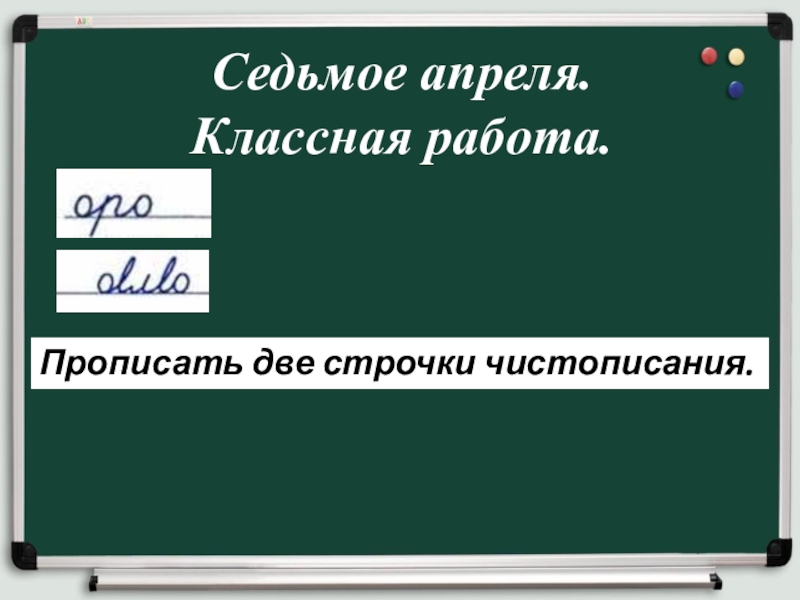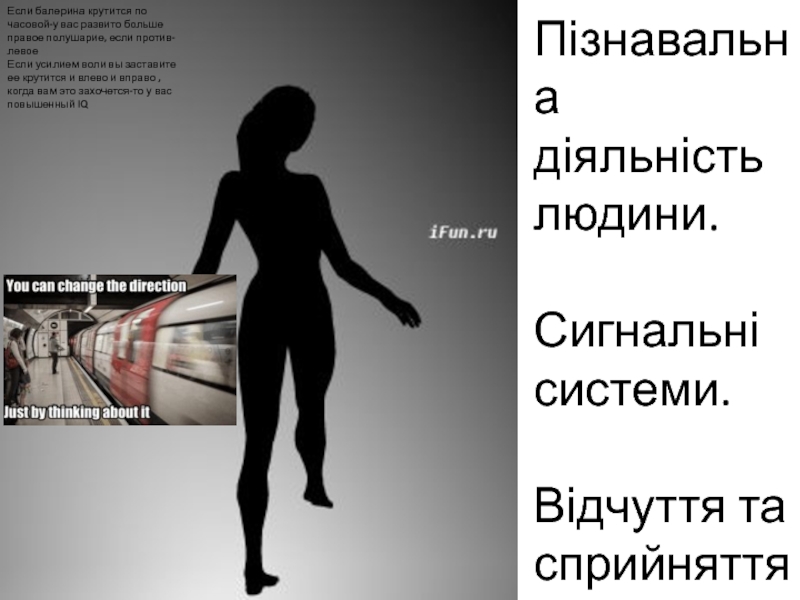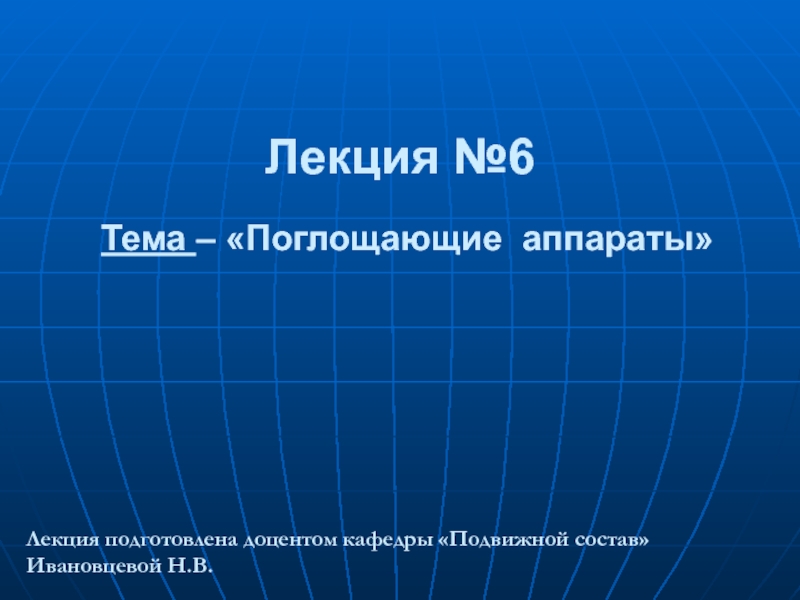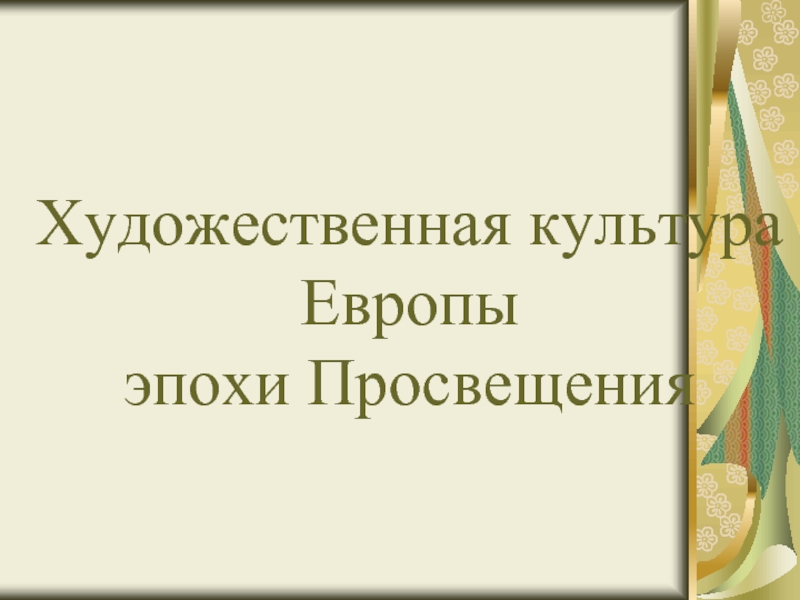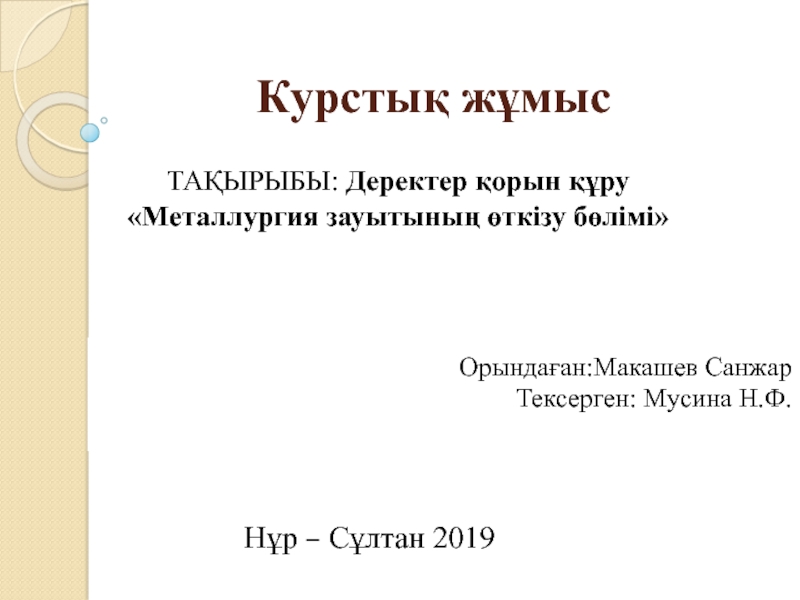Разделы презентаций
- Разное
- Английский язык
- Астрономия
- Алгебра
- Биология
- География
- Геометрия
- Детские презентации
- Информатика
- История
- Литература
- Математика
- Медицина
- Менеджмент
- Музыка
- МХК
- Немецкий язык
- ОБЖ
- Обществознание
- Окружающий мир
- Педагогика
- Русский язык
- Технология
- Физика
- Философия
- Химия
- Шаблоны, картинки для презентаций
- Экология
- Экономика
- Юриспруденция
cedec2011_RealtimePBR_Implementation_e
Содержание
- 1. cedec2011_RealtimePBR_Implementation_e
- 2. Image Based Lighting (IBL)Lighting that uses a
- 3. Physically Based IBLAd-hoc IBL vs. Physically-based IBLHas
- 4. Physically Based IBL advantagesGuarantees a rendering result
- 5. PBIBL implementationImplementing IBL as an approximation of
- 6. Equations substitute
- 7. Decompose integral Irradiance Environment Map (IEM)Pre-filtered Radiance Environment Map (PFREM)AmbientBRDF Volume Texture
- 8. Implement Ambient BRDFPrecompute this equation off line
- 9. AmbientBRDF texture usageFetch the textureFor specular componentUse
- 10. AmbientBRDF comparisonAmbientBRDF OFFAmbientBRDF ON
- 11. Generate texturesUse AMD CubeMapGen?It can't be used
- 12. Generate texturesUse AMD CubeMapGen?It can't be used
- 13. Generate IEMImplement this equation straightforwardly on GPUDiffuse
- 14. Generate IEM (2) Using a radiance map reduced
- 15. Optimize diffuse termUsing SH lighting instead of
- 16. Generate REMPre-filtered Mipmapped Environment MapCompute the equation
- 17. Fitting shininess
- 18. Generate PMREM (1)Box-filter kernel filteringSimply use bilinear
- 19. Box kernel filter
- 20. Generate PMREM (2)Gaussian kernel filteringApply 2D Gaussian
- 21. Gaussian kernel filter
- 22. Generate PMREM(3)Spherical Phong kernel filteringThe shininess values
- 23. Spherical Phong kernel filter
- 24. Phong kernel implementation(GPU)Brute force implementation similar to
- 25. Phong kernel implementation(CPU)Offline generation by the tool
- 26. Generate PFREM (4)Poisson kernel filteringImplemented a faster
- 27. ComparisonsBox kernel filterGaussian kernel filterSpherical Phong kernel filterSpherical Phong kernel filter
- 28. Mipmap LODMipmap LOD parameter is calculated for
- 29. Edge overlappingNeed to solve the cubemap boundary
- 30. Edge overlapping (1)Blend adjacent boundaries by 50%Simplified
- 31. Edge overlapping (1)
- 32. Edge overlapping (2)Blend multiple texelsFor the next
- 33. Edge overlapping (3)4 texel blend?More blends don’t
- 34. Bent Phong filter kernelThis algorithm blends normals
- 35. Bent Phong filter kernel
- 36. Bent Phong filter kernelBent Phong filter kernelEdge overlapping w/ Phong filter kernel
- 37. Implemented configurationsDynamic IBLStatic IBL
- 38. Problems with large shininessIn practice with IBL,
- 39. IBL BlendingBlending is necessary when using multiple
- 40. IBL Blending
- 41. IBL OffsetA little tweak for a local
- 42. Matching IBL with point lightIn the case
- 43. Shininess hackNot mathematical matching, but matching the
- 44. Shininess hack
- 45. Shininess hack
- 46. HDR IBL ArtifactThe rendering result looks unnatural
- 47. HDR IBL Artifact
- 48. Why does the artifact occur?Because it is
- 49. Multiplying by AO factorIs not enoughEnough for
- 50. Novel Occlusion FactorNeed almost zero for occluded
- 51. Specular OcclusionSO is acquired from AOUse AO
- 52. Aqcuire Specular OcclusionIn the case where a
- 53. Specular Occlusion implementationRequired SO (Specular Occlusion) factor
- 54. Specular OcclusionAmbient OcclusionSpecular Occlusion
- 55. SO implementation (1)The first equation that satisfies
- 56. SO implementation (1)
- 57. SO implementation (2)Equation taking into account the
- 58. SO implementation (2)
- 59. SO implementation (3)Optimizing the second equationThe physically
- 60. SO implementation (3)
- 61. Ambient specular term computationComputing the final ambient
- 62. Ambient specular term computation
- 63. AS term computation (1)Computing pseudo interreflectionFundamentally, it
- 64. AS term computation (1)
- 65. AS term computation (2)Multiplying by the AO
- 66. AS term computation (2)
- 67. AS term computation (3)Again, the AO factor
- 68. AS term computation (3)
- 69. AS term computation (4)The secondary AO factor
- 70. AS term computation (4)
- 71. Applying to the entire specular termSO factor
- 72. W/o Specular Occlusion (Only AO)
- 73. With Specular Occlusion
- 74. IBL performancems @ 1280x720
- 75. Physically based IBL
- 76. Physically based IBL
- 77. Physically based IBLWith the specular term for IBLWithout the specular term for IBL
- 78. ConclusionWhen using physically based IBLArea lighting which
- 79. AcknowledgementsR&D department, tri-Ace, Inc.Tatsuya ShojiElliott Davis
- 80. Questions?http://research.tri-ace.com
- 81. Скачать презентанцию
Слайды и текст этой презентации
Слайд 2Image Based Lighting (IBL)
Lighting that uses a texture (an image)
as light source
a broad sense, environment mapping is one of techniques of Image Based LightingСлайд 3Physically Based IBL
Ad-hoc IBL vs. Physically-based IBL
Has the same differences
and similarities between ad-hoc rendering and physically based rendering
Ad-hoc
renderingEach process needed for rendering is implemented one by one, ad-hoc
Physically Based Rendering
The entire renderer is designed and built based on physical premises such as the Rendering Equation and etc.
Слайд 4Physically Based IBL advantages
Guarantees a rendering result that is close
to shading under punctual light sources
Materials in a scene dominated
by direct lighting and indirect lighting seem the sameConsistency is preserved through different lighting
Artists spend less time tweaking parameters
Even in a scene dominated by indirect lighting, materials look realistic
No need to use an environment map for glossy objects
Just add an IBL light source
Слайд 5PBIBL implementation
Implementing IBL as an approximation of the rendering equation
Physically
Based Image Based Lighting is one of possible examples to
reasonably implement physically based renderingСлайд 7Decompose integral
Irradiance Environment Map (IEM)
Pre-filtered Radiance Environment Map
(PFREM)
AmbientBRDF Volume
Texture
Слайд 8Implement Ambient BRDF
Precompute this equation off line and store result
to a volume texture
U – Dot product of eye vector
(w) and normal (n)V – shininess
W – F0
Слайд 9AmbientBRDF texture usage
Fetch the texture
For specular component
Use the value for
For
diffuse component
Rd*(1 – the value)
For optimization
Ideally values for diffuse component
should be precomputed and stored to the texture for accurate shadingСлайд 11Generate textures
Use AMD CubeMapGen?
It can't be used for real-time processing
on multi-platform, because it is released as a tool /
libraryСлайд 12Generate textures
Use AMD CubeMapGen?
It can't be used for real-time processing
on multi-platform, because it is released as a tool /
libraryEven so, the quality is not perfect and there is room for improvement
But it has become open-source
Слайд 13Generate IEM
Implement this equation straightforwardly on GPU
Diffuse BRDF is Lambert
In
the case of IBL, the use of other models doesn't
bring any significant differencesStrictly speaking, it depends of the intensity distribution in an IBL image
Texture resolution is 16x16x6
Слайд 14Generate IEM (2)
Using a radiance map reduced to 8x8x6
Store accurately
precomputed Dw to the texture using spherical quadrilateral
AMD CubeMapGen uses
approximated DwNormalizing coefficient is also stored in the texture
Fp16 format
8x8x5 = 320tap filter on GPU
Xbox360 0.5ms
PS3 2.0ms
Would be better on SPU
Слайд 15Optimize diffuse term
Using SH lighting instead of IEM for a
high performance configuration
Our engine already implements SH lighting
No extra GPU
costCompute the coefficients from 6 texels at the center in each face
Irradiance Map
Spherical Harmonics
Слайд 16Generate REM
Pre-filtered Mipmapped Environment Map
Compute the equation with different shininess
values and store results to each mipmapped texture
Blinn based NDF?
Approximated
with PhongThis is a compromise solution because the specular highlight shape changes due to different microfacet models
Only fitting the size difference of NDFs using shininess
Слайд 18Generate PMREM (1)
Box-filter kernel filtering
Simply use bilinear filtering to generate
mipmaps
LOD values are set according to shininess
Quality is quite low
Not
even an approximationUse as a fastest profile for dynamic PMREM generation
Слайд 20Generate PMREM (2)
Gaussian kernel filtering
Apply 2D Gaussian blur to each
face
Not physically based
As the blur radius increases, visual artifacts from
error in Dw become noticeableThe cube map boundary problem is noticeable
Even using overlapping (described later) for slow gradation generated by the blur process, since filtering isn’t performed over edges, banding is perceived on the edges when colors are changed rapidly
Use as the second fastest profile for dynamic PMREM generation
Слайд 22Generate PMREM(3)
Spherical Phong kernel filtering
The shininess values are converted using
the fitting function
The cube map boundary problem still exists
We expected
to solve it before the implementationThe reason is that, since the centers of adjacent pixels across the edges are not matched, the filtered colors are also not matched
Слайд 24Phong kernel implementation(GPU)
Brute force implementation similar to irradiance map generation
In
the final implementation, a face is subdivided into 9 rectangles
for texture fetch reductionFaster by 50%
9x6=54 shaders are used for each mip level
Subdivision is not used below 16x16
It becomes ALU bound as texture cache efficiently works for smaller textures
Слайд 25Phong kernel implementation(CPU)
Offline generation by the tool for static IBL
SH
coefficients and PMREM are automatically generated during scene export
For performance,
64x64x6 PMREM is only supported for static IBLBrute force implementation
All level mipmaps are generated from the top level texture at the same time
Core2 8 hardware threads @ 2.8GHz
64x64x6 : 5.6s
32x32x6 : 0.5s
SSE & multithread
Слайд 26Generate PFREM (4)
Poisson kernel filtering
Implemented a faster version of Phong
kernel filtering
Apply about 160tap filter with one lower level mipmap
textureQuality is compromised even with this process
Many taps are needed for desired quality
Didn’t work as optimization
Didn’t work well with Overlapping process
Not used because of bad quality and performance
Слайд 27Comparisons
Box kernel filter
Gaussian kernel filter
Spherical Phong kernel filter
Spherical Phong kernel
filter
Слайд 28Mipmap LOD
Mipmap LOD parameter is calculated for generated PMREM
Select the
mip level according to shininess
Using texCUBElod() for each pixel
a is
calculated according to the texture size and shininessWith trilinear filtering
Each shininess value corresponding to each mip level is calculated by fitting
Fitted for both Box Filter Kernel and Phong Filter Kernel
Слайд 29Edge overlapping
Need to solve the cubemap boundary problem
No bilinear filtering
is applied on the cubemap boundaries of each face with
DX9 hardwareProblematic especially for low resolution mipmaps (1x1 or 2x2)
Edge fixup in AMD CubeMapGen
Слайд 30Edge overlapping (1)
Blend adjacent boundaries by 50%
Simplified version of AMD
CubeMapGen’s Edge Fixup
Adjacent texels across the boundaries become the same
colorsIf corners, the colors become the average of adjacent three texel colors
If 1x1, the color becomes the average of all faces
All texels become the same color
Banding is still noticeable because color gradation velocity varies
Слайд 32Edge overlapping (2)
Blend multiple texels
For the next step, blend 2
texels
In order to reduce gradation velocity variation, blend 2 texels
by 1/4 and 3/4 ratioSame approach as CubeMapGen
However, banding is still noticeable in the case where gradation acceleration drastically varies
As the area where banding is noticeable increases, the impression gets worse
Because the blurred area increases, the accuracy of the integration decreases
Worse rendering quality
Слайд 33Edge overlapping (3)
4 texel blend?
More blends don’t make sense according
to our research
4 texel blending in CubeMapGen is not so
high qualityMoreover, the precision as a signal decreses
Слайд 34Bent Phong filter kernel
This algorithm blends normals instead of colors
Similar
to the difference between Gouraud Shading and Phong Shading
The normal
from the center of the cube map through the center of the texel is bent by an offset angle The offset angle is interpolated from zero at the center of the face to a target angle at the edge
The target angle is the angle between the two normals of adjacent faces’ edge texels
The result from just the above steps was improved, but still not perfect
Then, using only 50% of target angle gave a much better result
In the final implementation, the target angle is additionally modified based on the blur radius
Large radius : 100% of target angle used
Small radius : 50% used
Since optimal values for the target angle are image dependant, adjust the values by visual adjustment instead of mathematical fitting
Слайд 38Problems with large shininess
In practice with IBL, materials still look
glossy even with shininess of 1,000 or 2,000
For mirror like
materials, shininess of ten thousands is preferredDifficult to have high enough resolution mipmap textures, because of memory and performance issues
Adding the mirror reflection option
When this functionality is turned on, the original high resolution texture is automatically chosen
Слайд 39IBL Blending
Blending is necessary when using multiple Image Based Lights
Implemented
blending between an SH light and an IBL
Popping was annoying
when the blend factor cross 50%Not practical
Blending by fetching Radiance Map twice
Diffuse term is blended with SH
For optimization, this process is performed only for the specified attenuation zone
Switching shader
Слайд 41IBL Offset
A little tweak for a local reflection problem with
IBL
The usual method
Reflection vector is modified according to the virtual
IBL positionc is computed from the IBL size, the object size and another coefficient which is adjusted by hand
With IBL Offset
Слайд 42Matching IBL with point light
In the case where area lighting
becomes practical with IBL, punctual lights becomes problematic
When adjusting specular
for punctual lights, artists tend to set smaller (blurrier) shininess values than physically based valuesBut it is too blurry for IBL
When adjusted for IBLs, it is too sharp for punctual lights
No way for artists to adjust specular without matching
Слайд 43Shininess hack
Not mathematical matching, but matching the result from punctual
lights to the result from IBL
Anyhow, this is a hack
The
coefficient can’t be precisely adjustedDepends on the shape of the object lit
Depends on the size of the light source
Shininess value is compensated by the lighting attenuation factor
In the case of distant light source, shininess value tends to be the original shininess value
In the case of close light source, shininess values tends to be smaller than the original value
Слайд 46HDR IBL Artifact
The rendering result looks unnatural when the high
intensity light that should be occluded is coming from grazing
anglesGenerally multiply by the ambient occlusion factor
Enough for LDR IBL
The artifact is noticeable when HDR IBL has a big difference of intensities, just like the real world
Multiplying by the ambient occlusion factor isn’t enough
Слайд 48Why does the artifact occur?
Because it is physically based
It is
sometimes very noticeable
It unnaturally looks too bright on some pixels
(edge of objects)This artifact occurs when all of the following are present: Fresnel effect, high intensity value from HDR IBL, physically based BRDF models, and high shininess values
Example of a material with a refractive index of 1.5
A difference of about 2,500times!
Слайд 49Multiplying by AO factor
Is not enough
Enough for LDR IBL and
non physically based
Unnoticeable
Not enough for HDR IBL and physically based
at allIf an AO factor is 0.1,
12.64*0.1=1.264 with the example
Still higher than 1.0
Need a more aggressive occlusion factor
Слайд 50Novel Occlusion Factor
Need almost zero for occluded cases
Not enough with
0.3 or 0.1 for HDR
Need 0.01 or less
Very small values
for not occluded area are problematicNeed to compute an occlusion term designed for the specular component
High-order SH?
No more extra parameters!
Слайд 51Specular Occlusion
SO is acquired from AO
Use AO factor as HBAO
or SSAO
But precomputed AO factor is not HBAO factor
Using AO
factor as HBAO factor that assumes that the pixel is occluded by the same angle for all horizontal directionsIn other words, you can consider that the same occlusion happens for all directions in the case of SSAO
Слайд 52Aqcuire Specular Occlusion
In the case where a pixel is isotropically
occluded from the horizon without gaps
AO factor becomes
Neither conventional AO
nor HBAO
are isotropic for horizontal directions,
but Specular Occlusion forcibly
assumes that it is
Слайд 53Specular Occlusion implementation
Required SO (Specular Occlusion) factor should satisfy the
following as much as possible
Where q = 0, SO =
0Where q = cos-1(AO0.5), SO = 0.5
Specular term becomes 0.5 where the pixel is occluded by a half at the occluded position
Where q = p /2, SO = 1
Слайд 55SO implementation (1)
The first equation that satisfies the condition
Though this
satisfies the conditions as Specular Occlusion, it is not physically
basedSince Specular Occlusion literally represents the occlusion factor for the specular term, it should be affected by the shininess value
Слайд 57SO implementation (2)
Equation taking into account the shininess value
More physically
based than the first one
SO suddenly changes with larger shininess
valuesHigh computational cost with Pow
A little visual contribution to the result
Smaller occlusion effect than expected
Слайд 59SO implementation (3)
Optimizing the second equation
The physically based correctness with
respect to shininess decreases
Stable as SO doesn’t take into account
shininessAverage occlusion effect becomes stronger
Optimized
The balance between quality and cost is good
Слайд 61Ambient specular term computation
Computing the final ambient term
With this equation,
the pixel gets black, because the occluded pixel isn’t lit
by the ambient lightsIn reality, the pixel would be illuminated by the some light reflected by some of the objects (interreflection)
The diffuse term has the same issue
AO itself is not such an aggressive occlusion term
Diffuse factor does not have such a high dynamic range
Not problematic
Problematic for the specular term
Unnaturally too dark
Слайд 63AS term computation (1)
Computing pseudo interreflection
Fundamentally, it should take into
account light and albedo at the reflected point
Because this implementation
is “pseudo”, it takes into account light and albedo at the shading pointThe results
Visually, we desired a little more aggressive occlusion effect
Not based on physics
Depending on the position, the rendering result becomes strange
This implementation does not take into account the actual interreflection
Слайд 65AS term computation (2)
Multiplying by the AO factor instead of
albedo
Interreflection like effect becomes smaller, but the occlusion effect becomes
strongerVisually preferable
Eventually, it depends on your preference
It is a good choice to make this an option for artists
Слайд 67AS term computation (3)
Again, the AO factor is multiplied by
the specular term
Makes the specular effect for ambient lighting robust
Not
based on physicsThe SO factor itself approximates the approximation
Relatively adjusted to conservative result
It also depends on your preference
Слайд 69AS term computation (4)
The secondary AO factor is only multiplied
by the diffuse term
Still your preference
This term is optional according
to your preferenceNot physical reason, but artistic direction
Слайд 71Applying to the entire specular term
SO factor is also available
for the specular term with punctual lights
In our case, this
is used for punctual lightsBig advantage with HDR, physically based materials and textures
With Specular Occlusion
Слайд 78Conclusion
When using physically based IBL
Area lighting which is difficult with
punctual lights becomes feasible
Soft lighting by a large light
sourceSharp lighting by a small light source
Consistent material representation with scenes by either direct and indirect lighting
Reduce hand adjustment by artists
Easy to set physically correct parameters to materials
True HDR representation becomes possible
